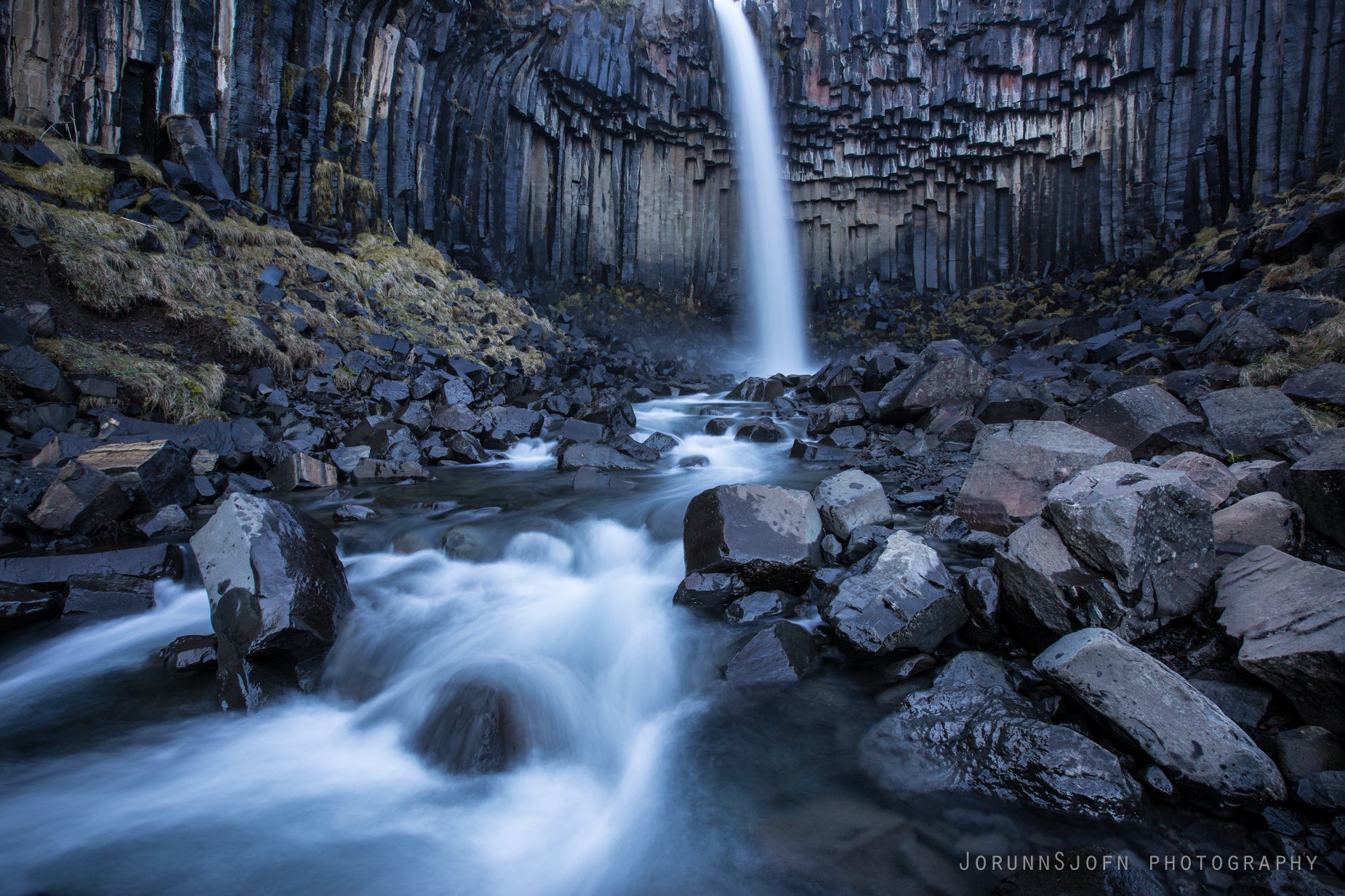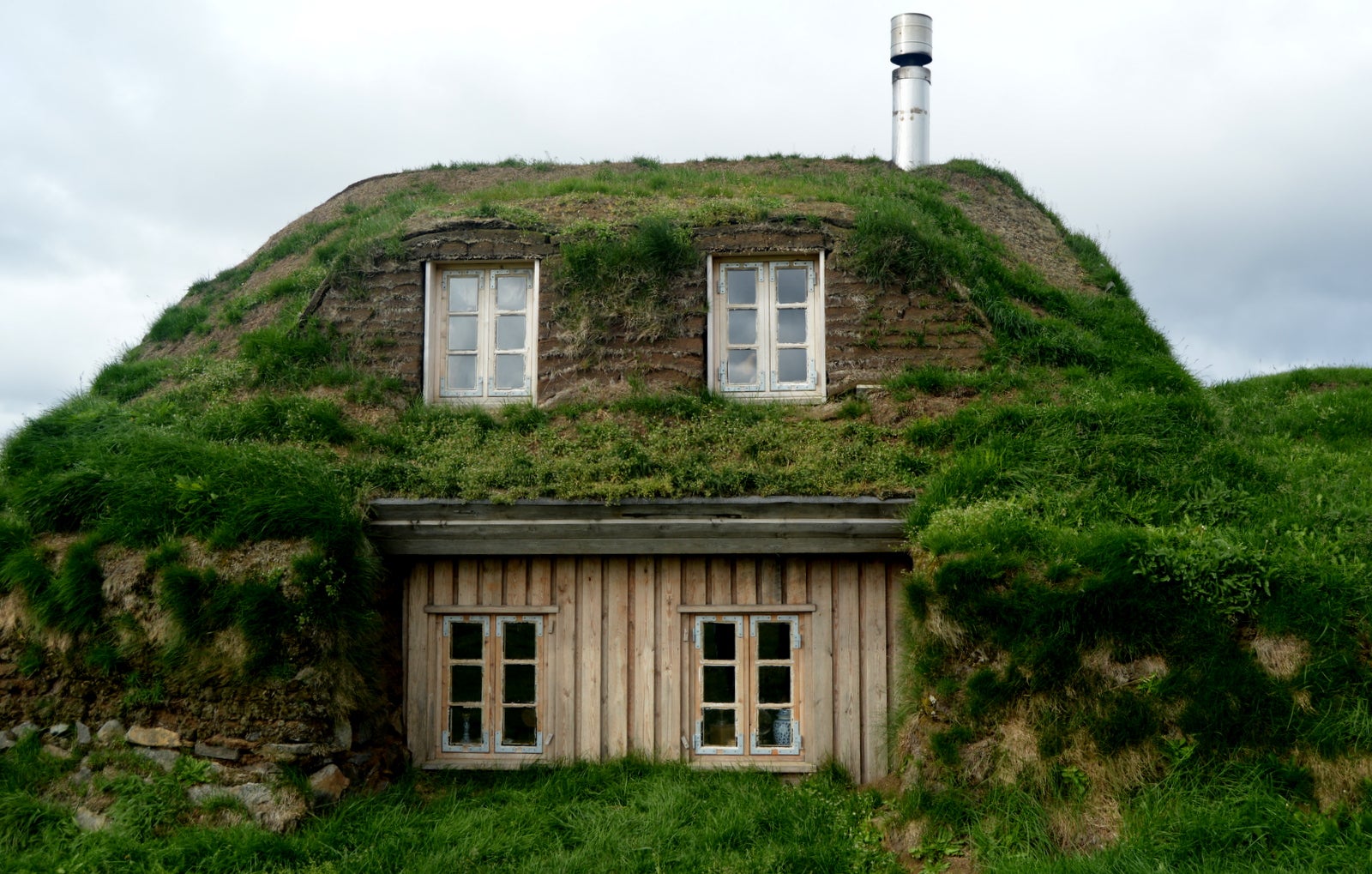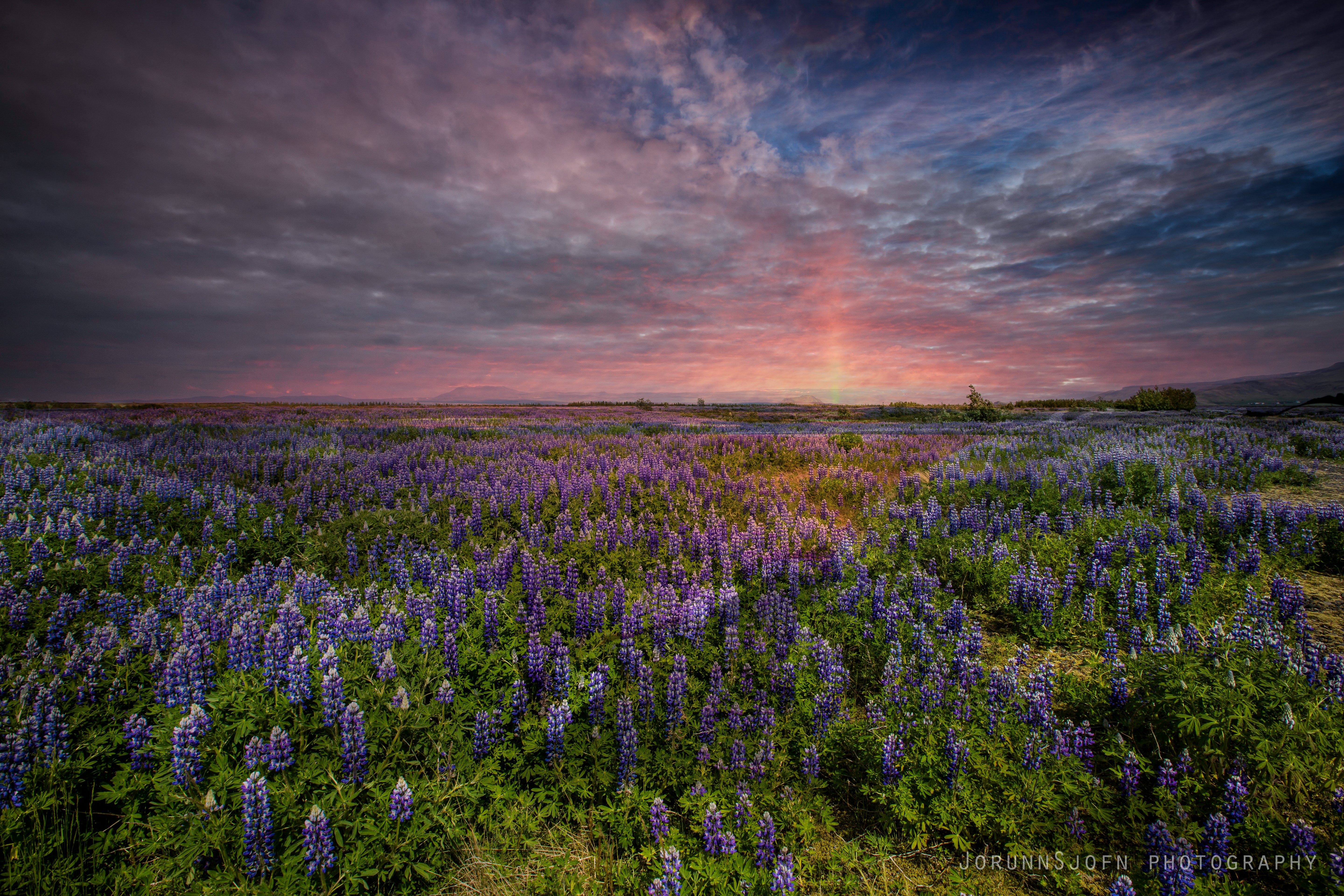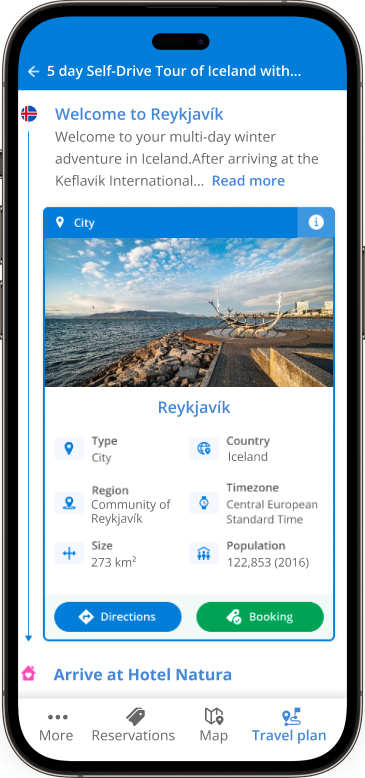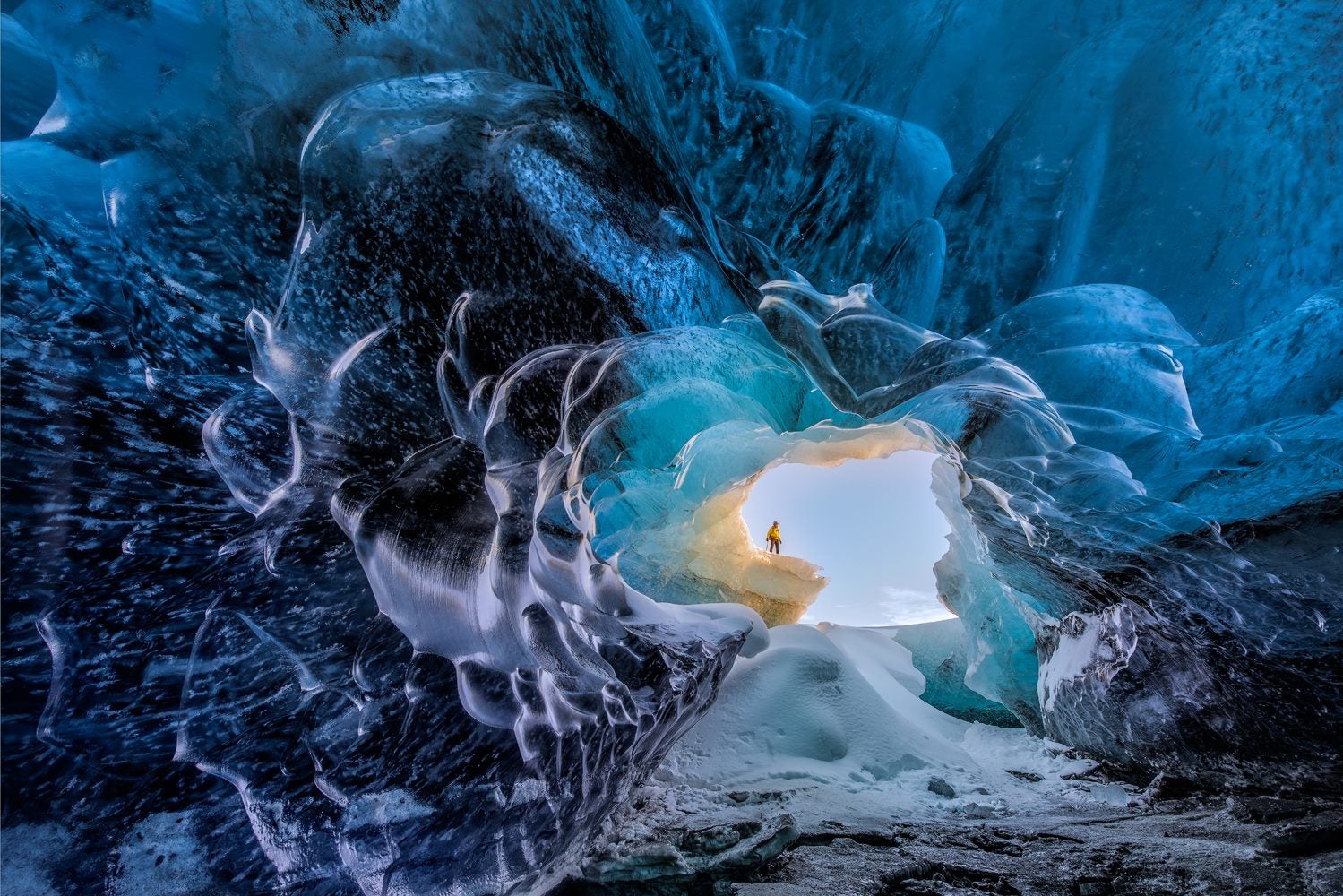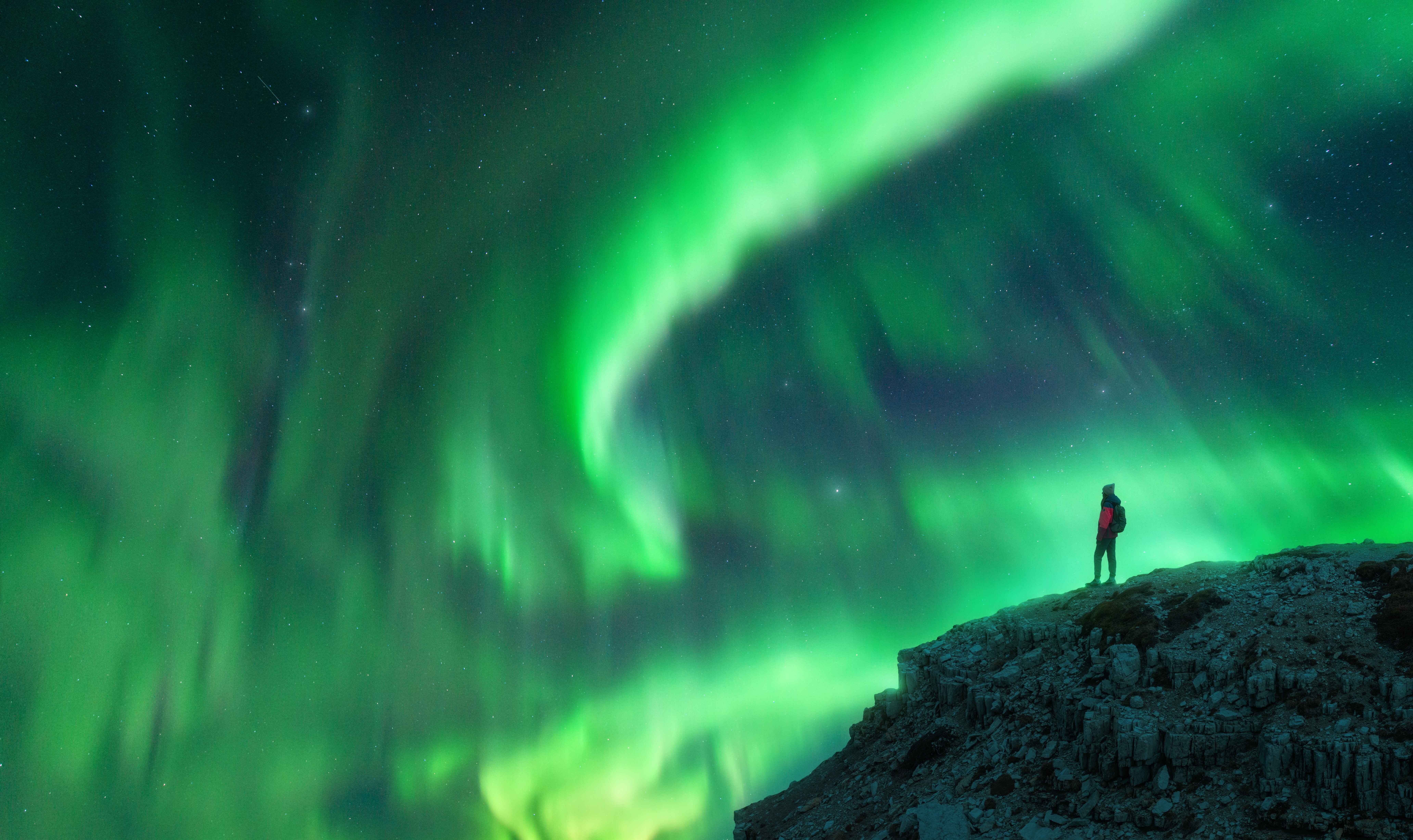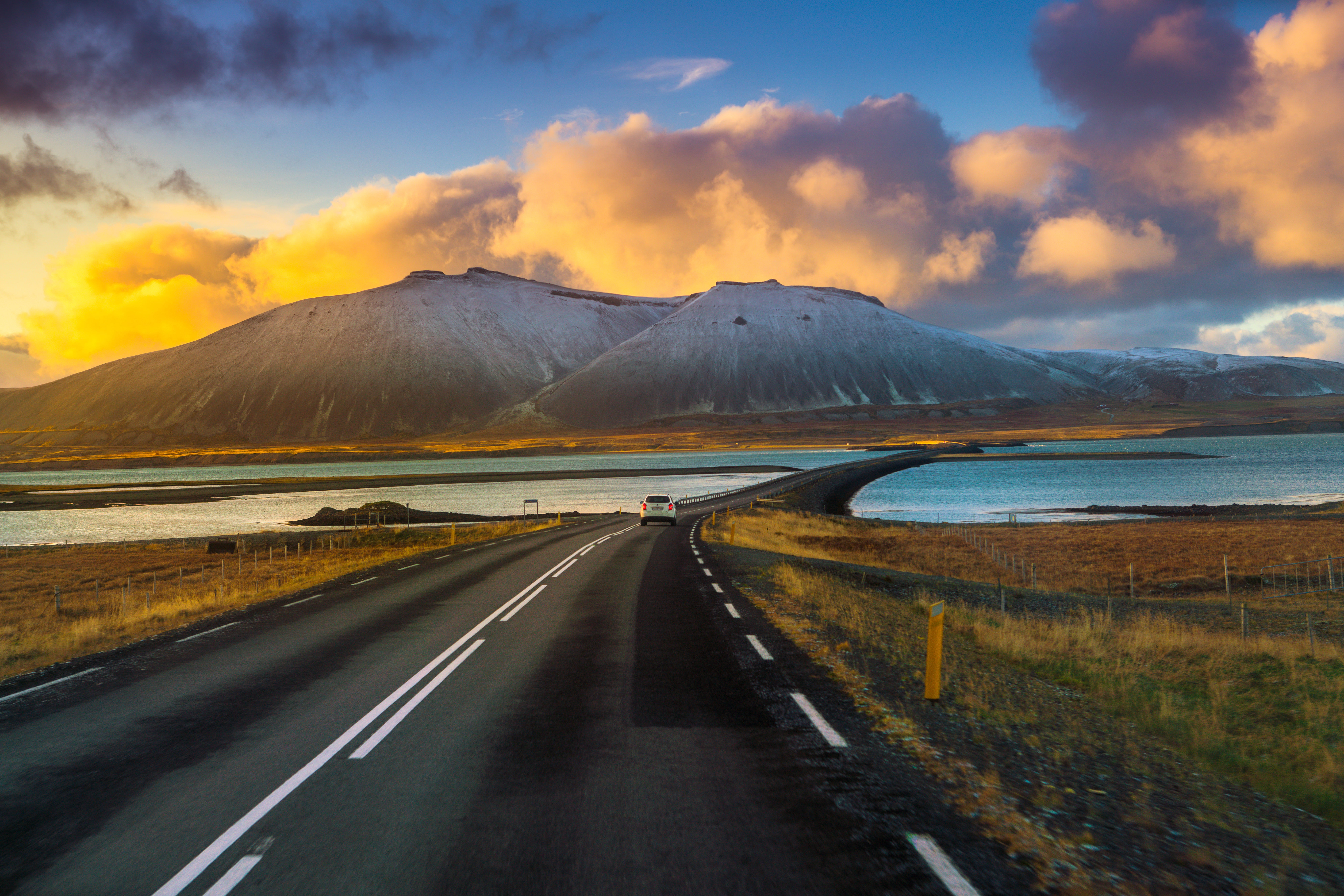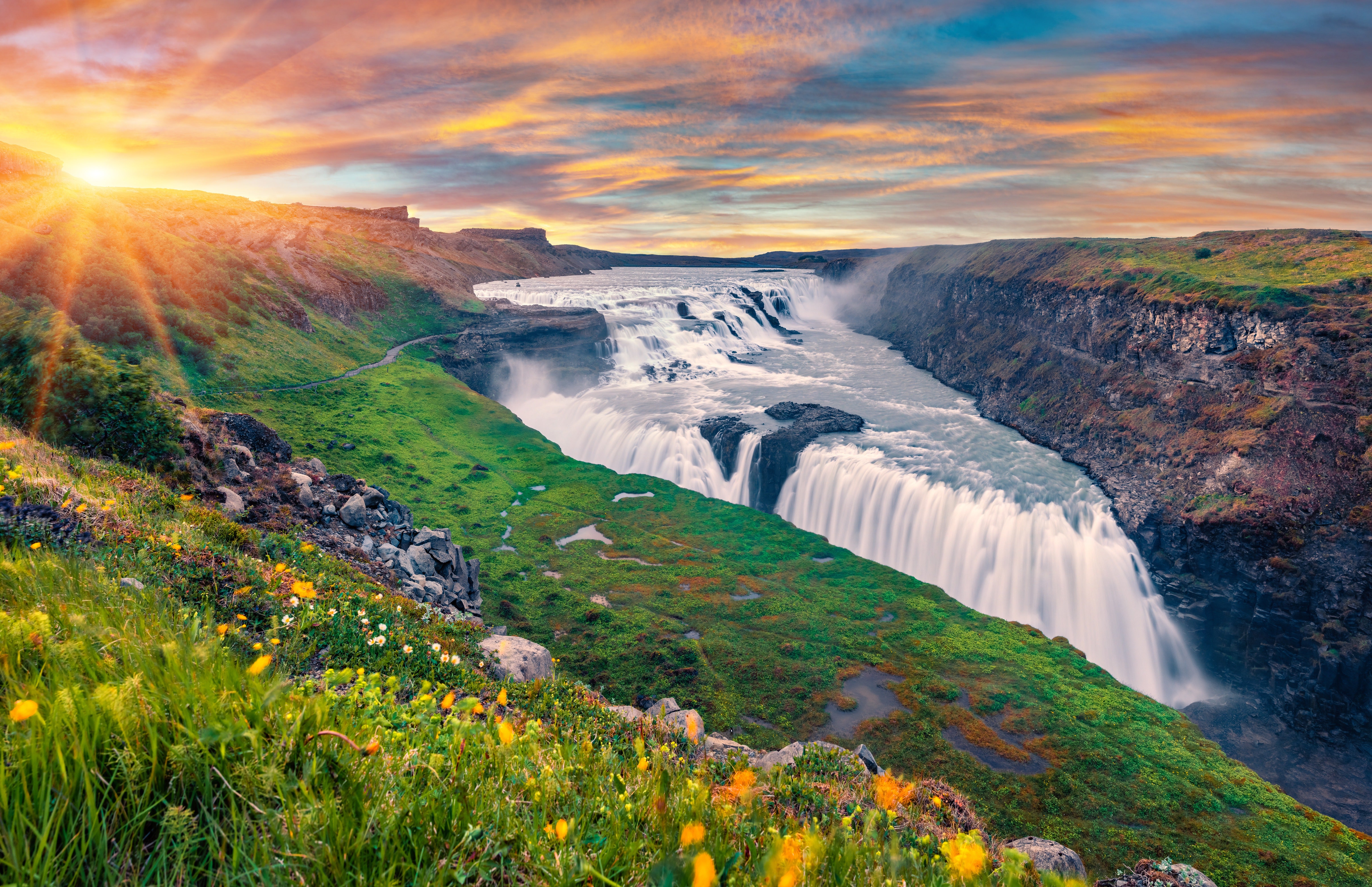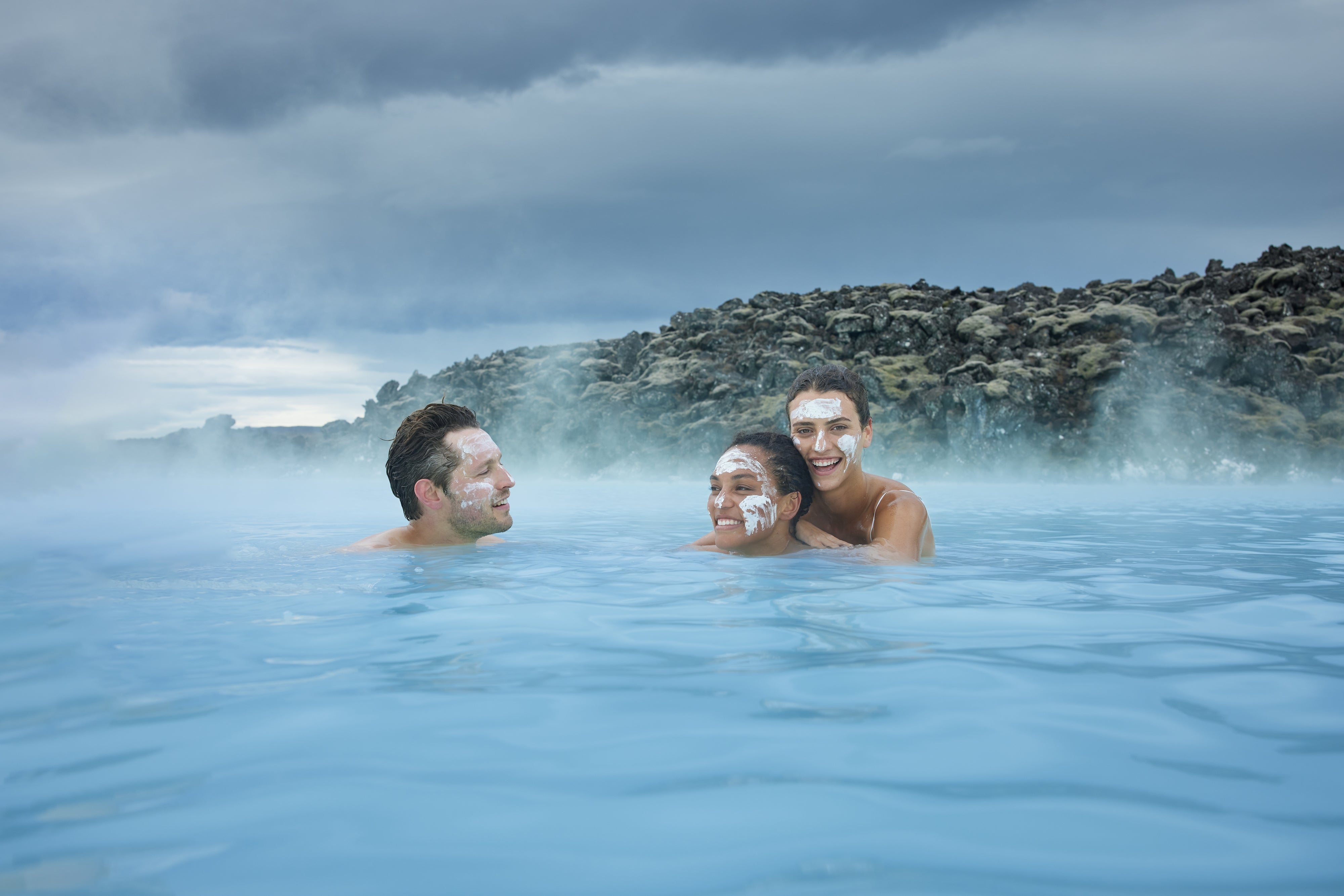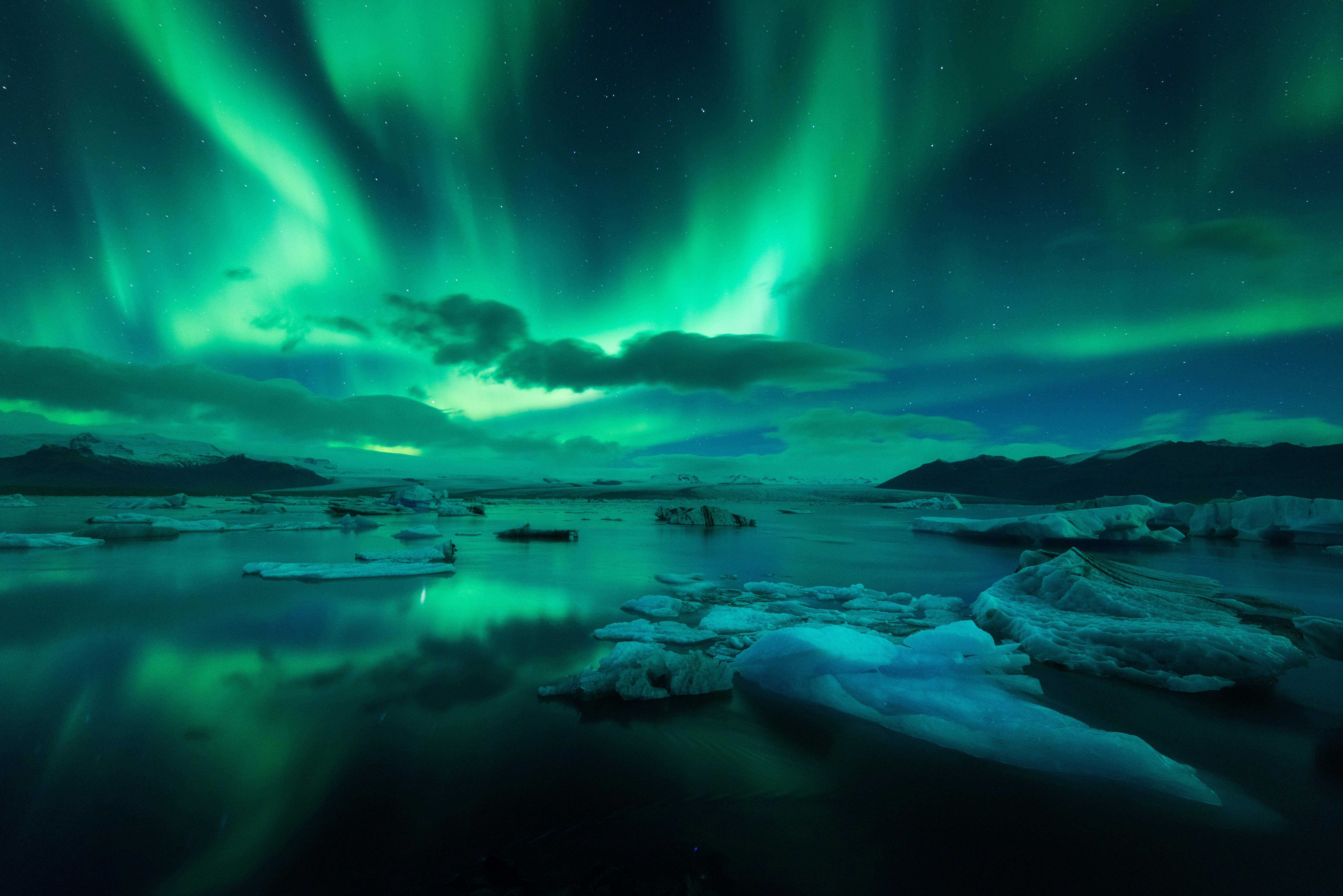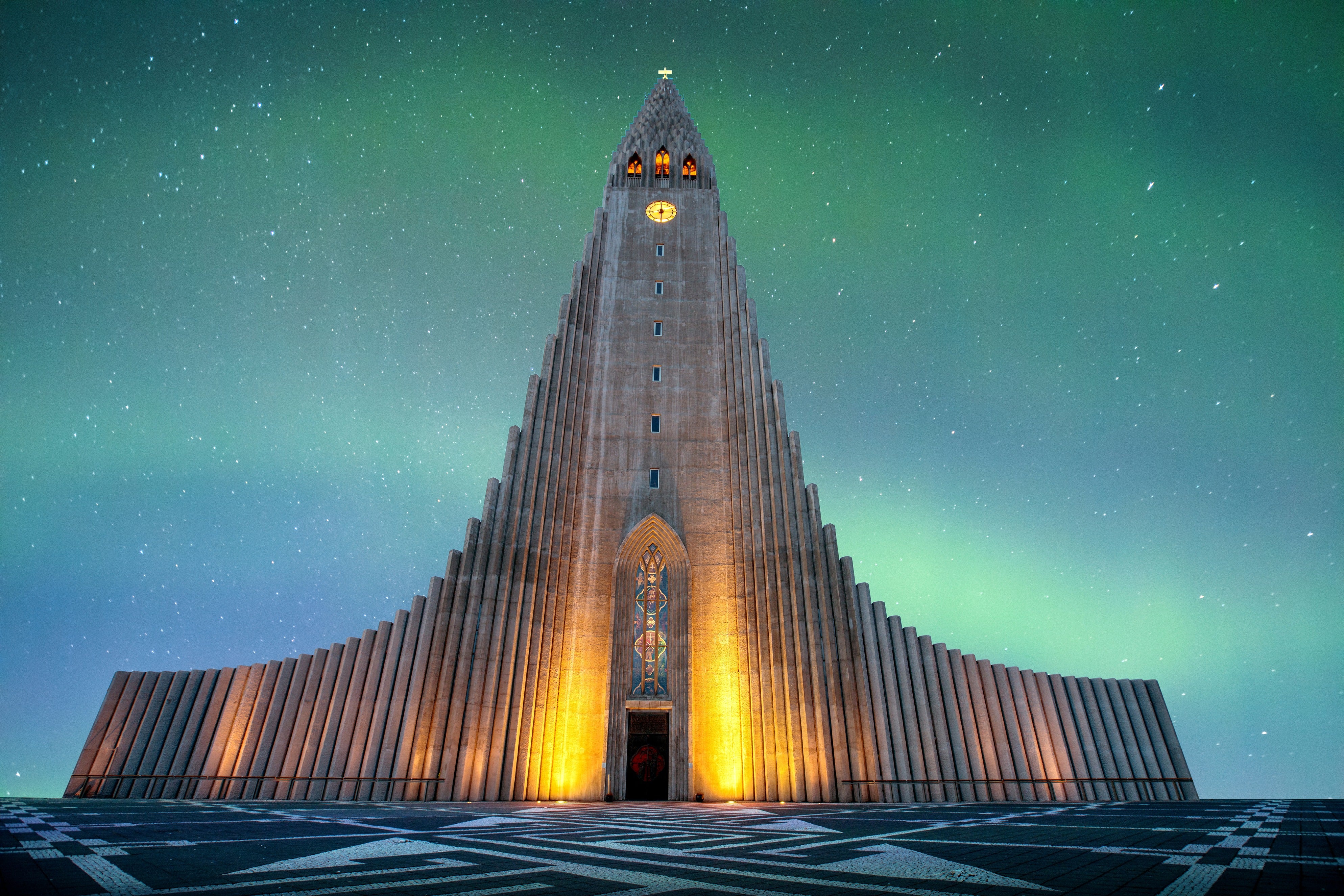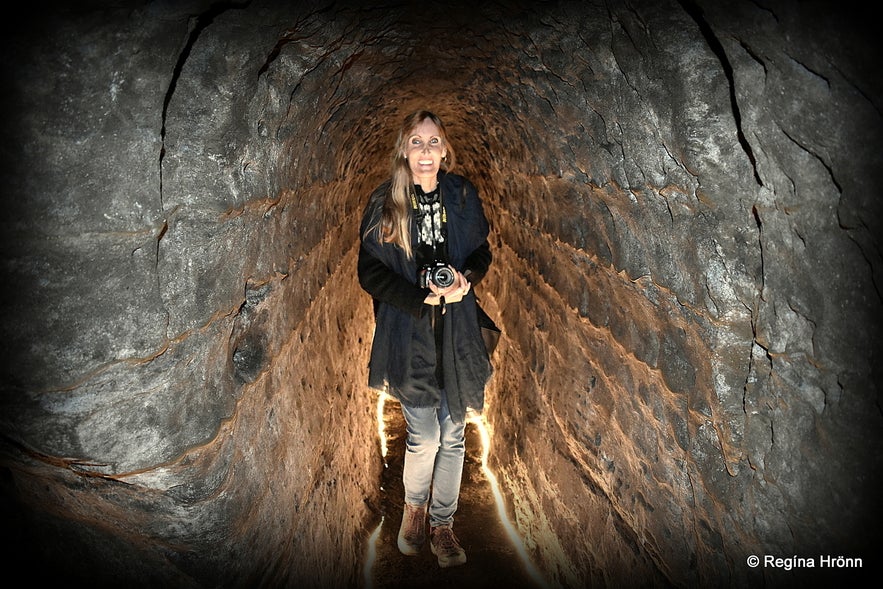
The best-known of these caves are the mystical Ægissíðuhellar - Hellarnir á Hellu - the Caves of Hella. They are amongst the largest man-made caves in Iceland.
I Joined 2 guided tours of the caves to be able to find out as much as possible about the origin of the caves, which is still a mystery to us.
Top photo: Inside the Caves of Hella - a passageway between two caves
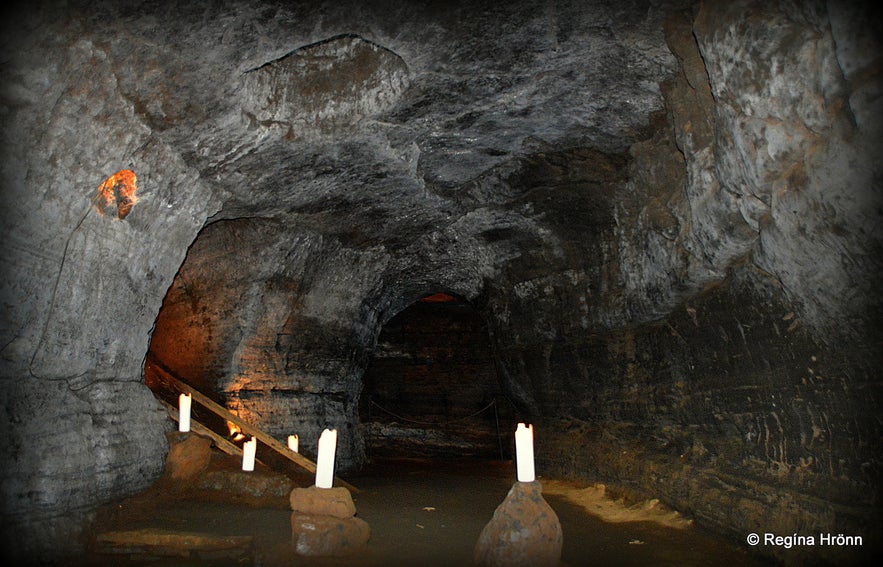
Inside the caves of Hella - Fjóshellir
Through the years I have written about many of Iceland's caves, some of which are very difficult to enter, like Lofthellir cave up north, so I was glad that the Caves of Hella are easily accessible.
Remember my travel-blog about the longest man-made cave in Iceland - Hellnahellir cave?
The Caves of Hella are in that same category and are most likely amongst the oldest still-standing structures in Iceland.
These caves are truly a historical wonder, but who built them, and when?
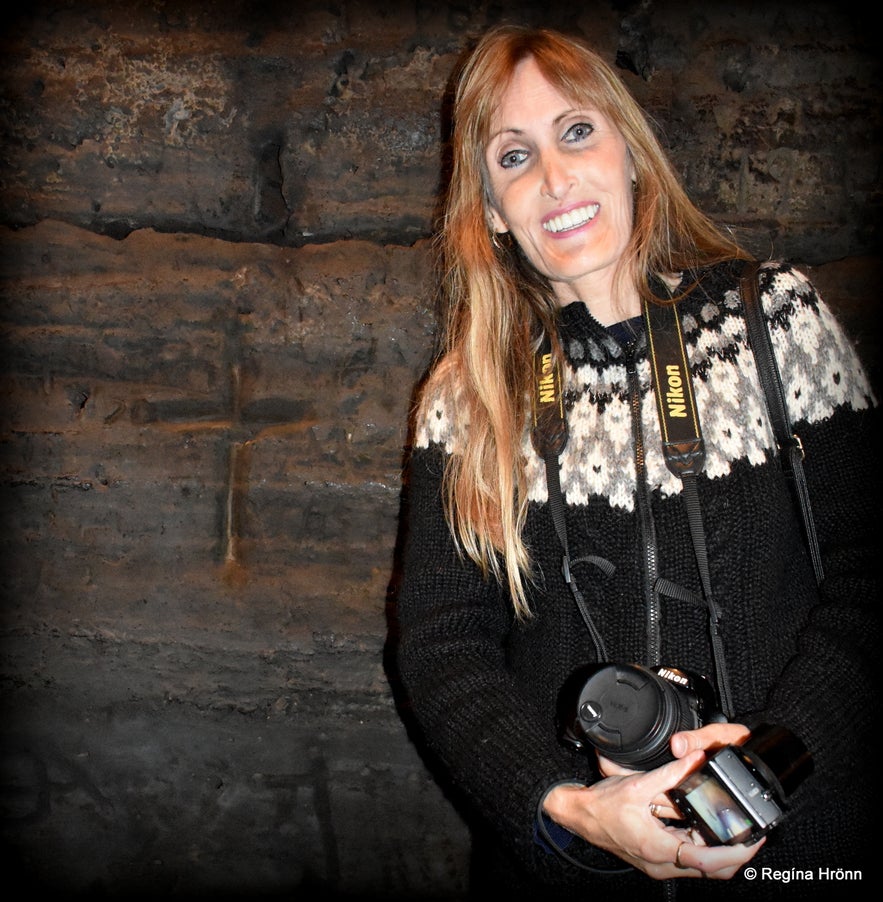 A cross carved into the cave wall
A cross carved into the cave wall
To be honest, we have no idea, but there are some speculations that they might even predate the Viking settlement of Iceland in around 874 AD.
There are many engravings on the walls of the caves, including several crosses, so we know that the people who used them were Christian, but the majority of the Norwegian settlers were heathen.
Landnáma - the Book of Settlement of Iceland tells us that there were some Irish monks called Papar living in Iceland when the Vikings arrived. They were no fans of the Vikings so they left.
And who can blame them, given how the monks had been treated by the Vikings in England, remember the Viking attack on Lindisfarne in 793?
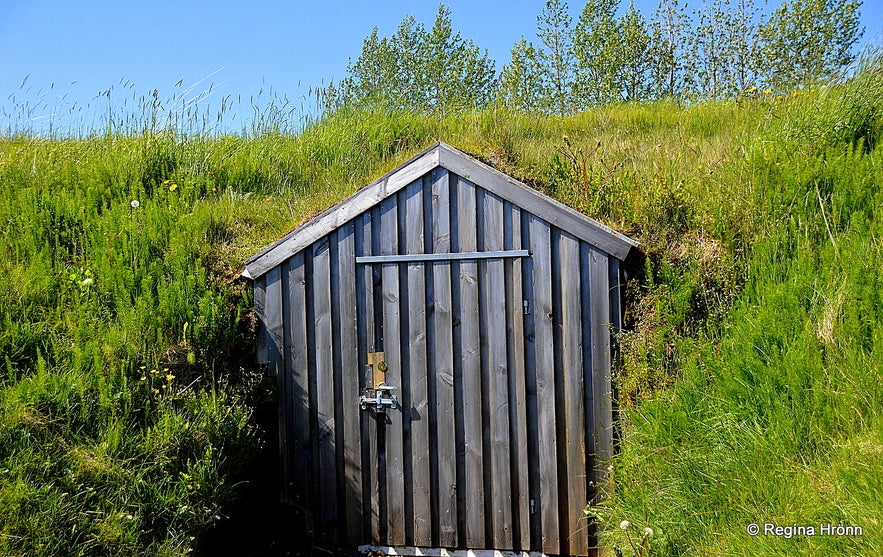
The entrance to Fjárhellir cave
The same family has taken care of the Caves of Hella for almost 200 years, the farmers at Ægissíða farm.
The family wanted to show these remarkable caves on their land to the public, and in cooperation and under the supervision of Minjastofnun - the Cultural Heritage Agency of Iceland they rinsed out the caves and restored them.
In 2019 the owners of the Caves of Hella opened 4 out of the 12 known caves to the public and offer guided tours of these 4 caves. Kudos to them for a job well done, I for one am glad that I was able to visit these amazing caves.
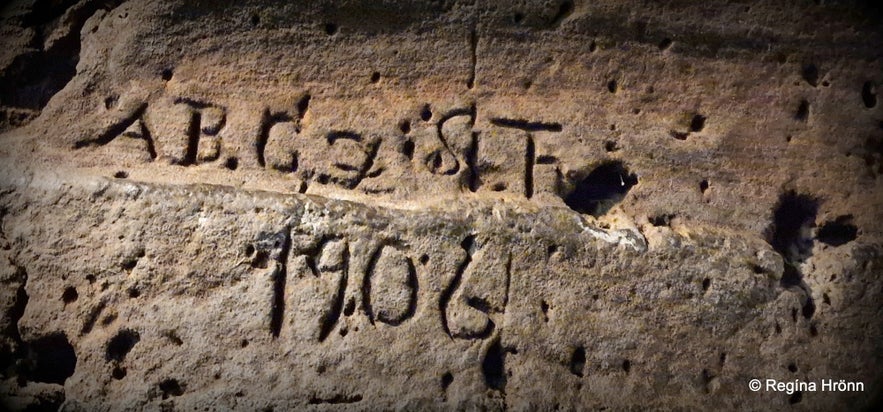 Carvings on the walls in the Caves of Hella
Carvings on the walls in the Caves of Hella
The proceeds from the admission fee go to the restoration of more caves and, hopefully, some of them will be accessible to the public in the near future.
One of the owners of the caves, Professor Baldur Þórhallsson, has guided in the caves ever since he was 5-6 years old, but his grandfather guided tourists in the caves.
Baldur grew up at Ægissíða and is very knowledgeable about these historical caves. At that time half of the caves were in use by his grandparents and parents.
And, he was a firm believer in the Irish settlement before the settlement of the Vikings back in 874 and that the Irish had made these caves.
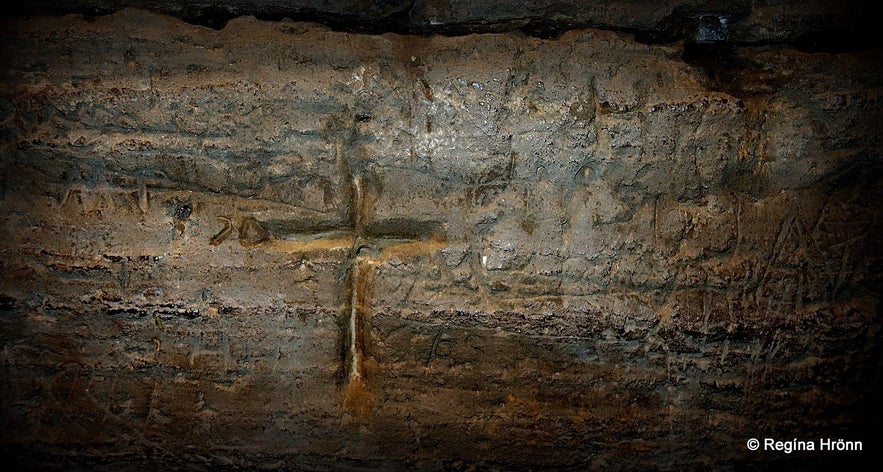 Crosses carved into the sandstone walls of the caves
Crosses carved into the sandstone walls of the caves
On the guided tour of the caves, the guides will tell you stories about the caves - about their mystical past, and the engravings on the sandstone walls.
And how these caves were used by the farmers as sheep sheds, dwellings, and storage for hey.
Sandstone is watertight unlike the lava caves, so it was an ideal place in which to live, to keep the hay, livestock or food. And remember that Icelanders lived in turf houses back then, which needed constant maintenance.
The sandstone caves seem to withstand earthquakes, given that they are properly maintained, but in this area, we experience the so-called Suðurlandsskjálfti - the Southern region earthquake every 100 years or so.
 Names and dates are carved on the sandstone walls of Hlöðuhellir cave
Names and dates are carved on the sandstone walls of Hlöðuhellir cave
The Caves of Hella are collectively called Ægissíðuhellar as I mentioned earlier. It is believed that there are 18 man-made caves at Ægissíða, 12 of which are now known.
The first written mention of these caves is an old rhyme from the latter part of the 18th century, where Guðlaug Stefánsdóttir from Selkot mentions that there are 18 caves at Ægissíða.
The name Ægissíða translated into English means by the sea (ægir is one of the Icelandic names we use for the sea). But the sea is far away from the caves, so why is it called Ægissíða?
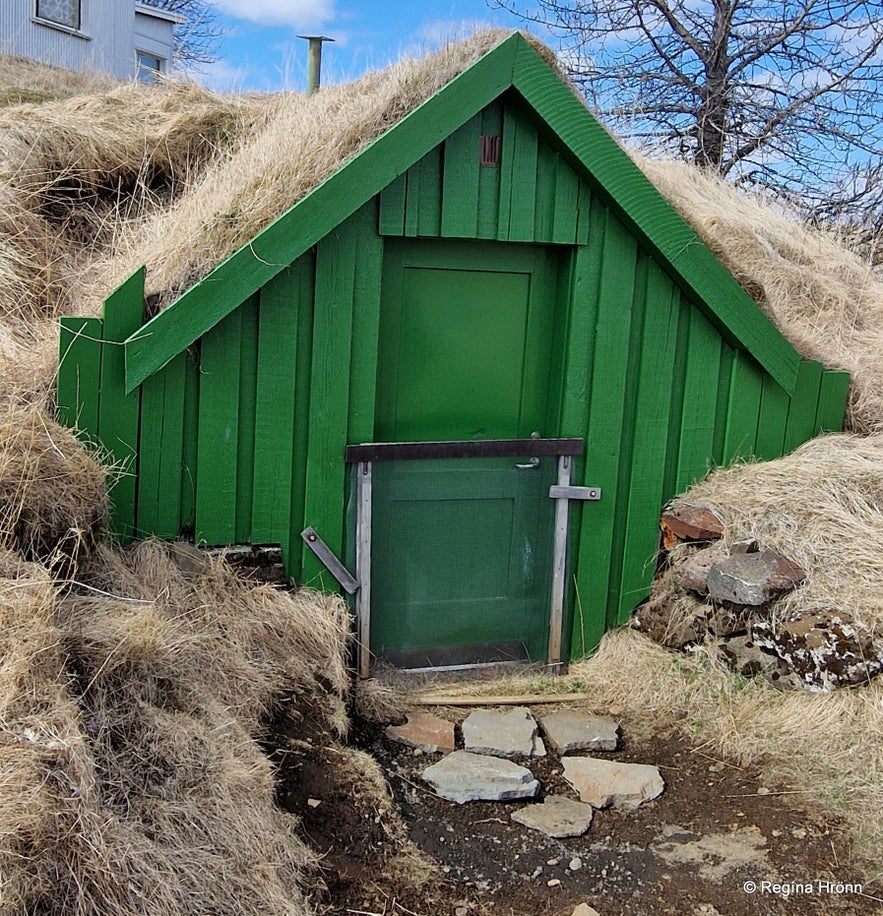 The entrance to one of the caves
The entrance to one of the caves
There are some speculations that this name is of Celtic origin (Gaelic) and means the people who live in the caves or the man-made caves.
Other speculations in our folklore are that they were called Ærsíða (ær meaning ewe) and one of our folklore tells the story behind that name.
I like to believe that the word is of Gaelic origin, but many Icelandic words are of Gaelic origin.
Genealogy shows that Icelanders are descendants of both the Nordic settlers and the Irish.
40-60 percent of Icelanders might be of Irish and Scottish origin. New DNA tests have shown that 20 percent of Icelandic men and 60 percent of Icelandic women have such genes.

The Vikings brought with them Irish slaves, but there are indications that there was an Irish population already in Iceland.
The Irish adopted Christianity centuries before the Norwegians (Icelanders) did, and they possessed the know-how to sail to Iceland way before the settlement of Iceland began.
And, the Irish St. Brendan the navigator (484-577) seems to have sailed to Iceland in 548.
So these extraordinary caves might predate the settlement of Iceland, even though that part of the history of my country is lost, and we only have bits and pieces that we are trying to puzzle together.
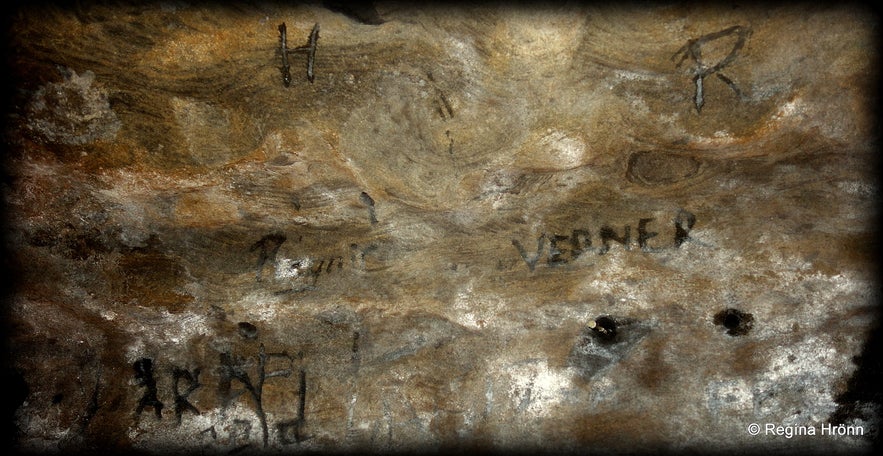 Engravings on the walls of Hlöðuhellir cave
Engravings on the walls of Hlöðuhellir cave
Later in this travel-blog I will tell you what sources we have got about the Irish.
We are hoping that with time we will find more evidence that our ancestors were not only the Viking settlers but Christian Celts, whose story has been lost.
Fjárhellir and Hlöðuhellir caves
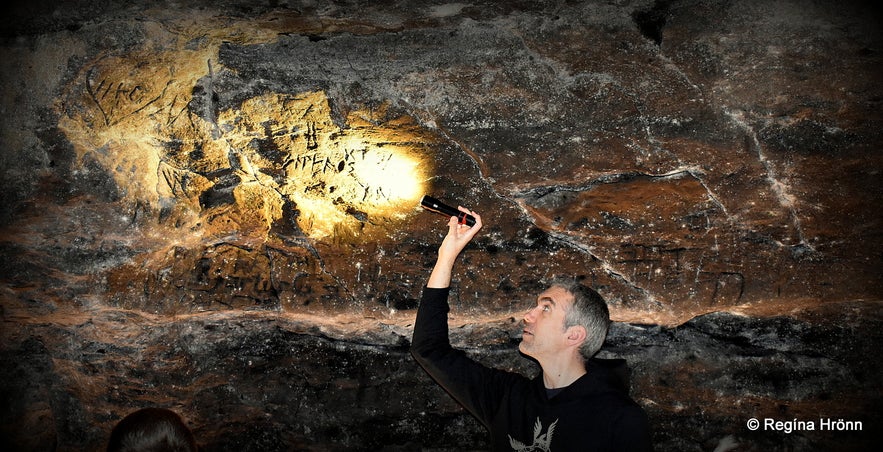
Our guide, Rökkvi, lit up some of the engravings on the walls in the caves
Our guide and friend Rökkvi, sometimes guides in the Caves of Hella, and he invited us on a tour of the caves.
He first showed us Fjárhellir cave - the Cave of the Sheep and used a flashlight to light up the engravings on the walls.
There are many engravings on the walls of the cave. It is very interesting to examine the names, dates, initials, and signs carved into the walls of the sandstone.
Some of the engravings are very old, others are younger, as it were, and some of the strange signs you will see in such caves are house marks (búmerki).
 On a guided tour of the Caves of Hella
On a guided tour of the Caves of Hella
Some of them look kind of strange to a city dweller and remind me of runes and magical staves.
In this cave, there was an opening in the ceiling, a chimney, through which light poured into the cave, and air, and if a fire was lit inside the caves it would let out the smoke.
Such openings were also used to throw hay into the caves.
I also saw an old well, but these wells are not ancient, the oldest ones seem to date back to the 19th century.
After examining Fjárhellir cave we entered Hlöðuhellir via a narrow passageway between the caves. It is a 10-meter-long carved tunnel carved in 1927.
 The passageway between the two caves is narrow but lit up
The passageway between the two caves is narrow but lit up
It is lit up and easy to pass, but if you are claustrophobic then you can exit the cave and enter Hlöðuhellir cave from the outside.
There is a myriad of dates, signs, and names carved into the walls of Hlöðuhellir cave, including the date 1913, which was very apparent and kind of stood out.
This was the year that this cave was discovered. A small boy crawled into the cave and measured it to be 11 meters long.
In 1916 when Minjastofnun and the owners of the cave dug it out it turned out to be twice as long, 22 meters.
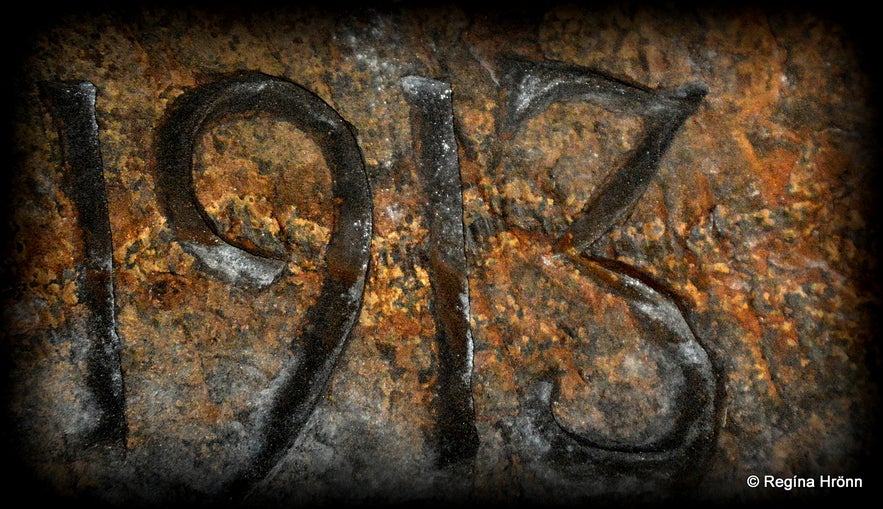
A date carved into the wall, it out of focus though as it is so difficult to take photos inside the cave
It seems like his cave was used for storing hay and later for storing potatoes. And in 1967 the entrance to the cave was widened so a tractor could enter it.
When you see the concrete entrance from the outside you have no idea that a historic cave is hidden behind it.
I had seen this entrance from the road when we were passing by and thought that it was a storage of some sort with grass on top.
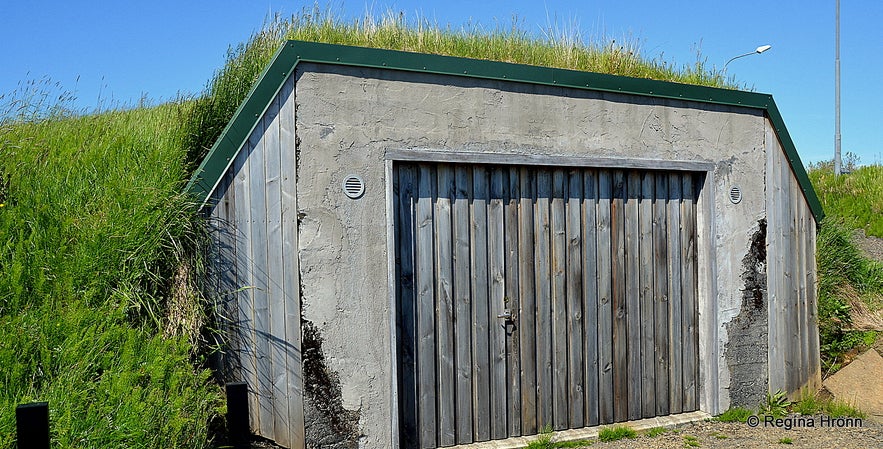 The entrance to Hlöðuhellir cave
The entrance to Hlöðuhellir cave
It is a bit tricky taking photos inside caves, should I use flash or no flash? I opted for using the flash.
Many of my photos are, unfortunately out of focus. I took photos with 3 cameras and my phone, but none of them were any good.
There is a special engraving in Hlöðuhellir cave, which you can see in my photo below, and the guide told us that it looks a bit like Arhus Vikingen masken.

A strange engraving on the walls of Hlöðuhellir cave
There are many cross carvings in the Caves of Hella. Here we spotted 2 crosses, but surely there were more that we didn't notice in the darkness.
In Hlöðuhellir cave, in one of the side caves, you will find barrels of Icelandic whiskey from Eimverk distillery, where my husband and the guide Rökkvi offer very popular whiskey distillery tours (you will get to taste 11 different types of their products).
The Flóki whiskey from Eimverk is the only Icelandic whiskey made with all Icelandic ingredients - from grain to glass. And the fields are at Bjálmholt farm in the vicinity of the Caves of Hella.
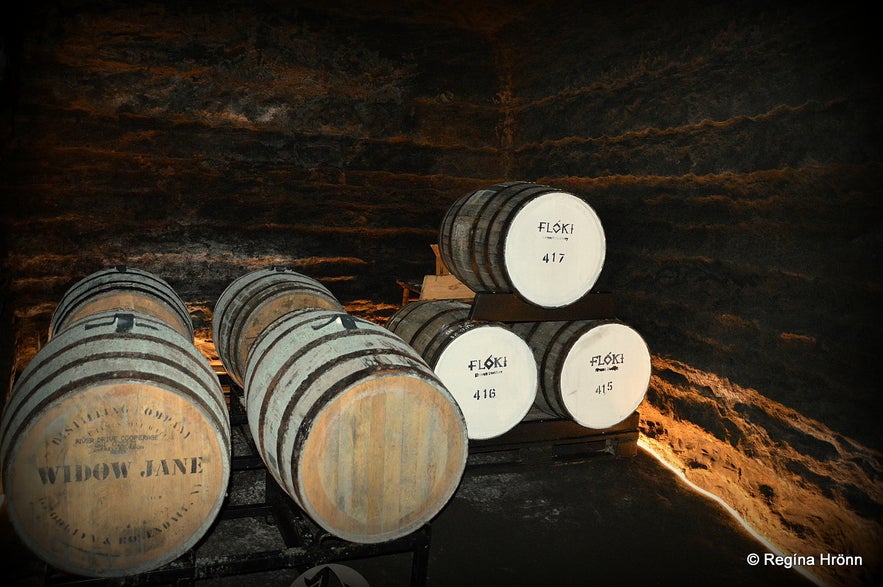
Hellaviskí - Cave whiskey from Eimverk distillery
If you book a luxury tour of the Caves of Hella you will get to taste the Flóki whiskey, together with beer sampling and tasting of local delicacies.
There are speculations as to whether this side cave had a curtain to close it as there are signs of ropes being used in this cave.
After examining Fjárhellir and Hlöðuhellir we crossed the field and walked to Fjóshellir cave with our guide Rökkvi, but that cave is one of the biggest one of the Caves at Hella.
Other caves at Hella are called Lambahellar, Kirkjuhellir, Brunnhellir, Búrhellir, Hrútshellir, and Skagahellir.
I took a short video of the surroundings when we were standing next to Kirkjuhellir cave
We stopped by a cave that was closed, Kirkjuhellir cave - the Church cave. I would love to be able to enter it one day.
A Catholic mass was held here in Kirkjuhellir cave back in 1950.
Brunnhellir - the Cave of the Well was discovered in 1907 when a horse stepped into a hole and I think that it fell into the cave.
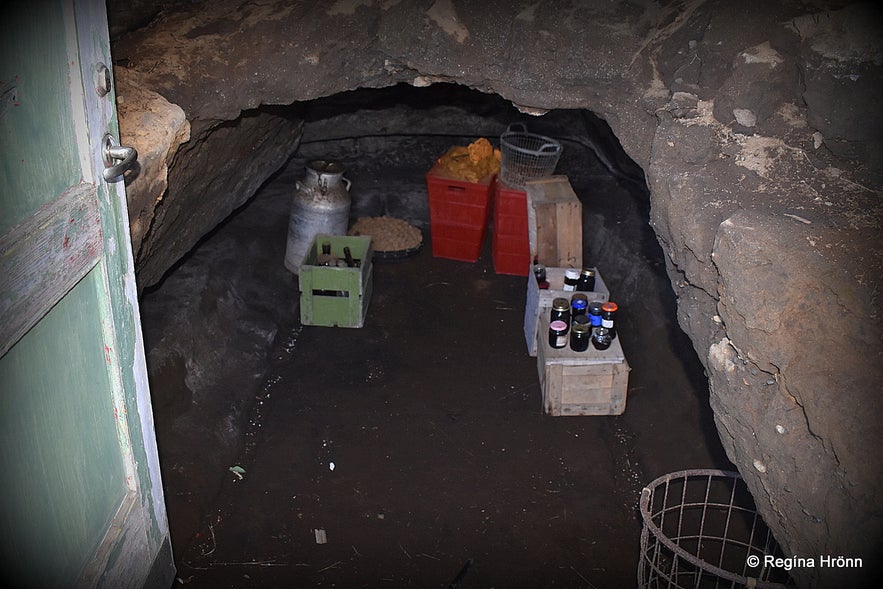 Food is stored in the small Skagahellir cave
Food is stored in the small Skagahellir cave
On the way to Hlöðuhellir cave we had a peek into Skagahellir cave, which is now used as a storage room for food.
Skagahellir was also used as an icehouse at some time and food was stored in some of the caves.
We now entered Fjóshellir cave.
Fjóshellir cave
 Fjóshellir cave and the Chapel
Fjóshellir cave and the Chapel
The name of the cave, Fjóshellir - the Cowshed Cave, describes the use the farmer had of the cave, although he did not use it to keep his cows, but as a storage room for hey.
A tunnel led from the cave to the cowbarn, which was in use until 1975.
The farmers stopped using the caves in the 1980s and they were abandoned until Baldur and his family restored the caves and opened them to the public.
A lot of work had to be done to restore the caves, they were cleaned out, and the entrances and stone chimneys were restored with a glass ceiling. And lights were added to the caves.

Our guide showed us short tracks in the cave
Our guide told us about the prominent tracks in Fjóshellir cave. A cart was used, which carried the hey from the cave and into the cowshed.
These tracks previously carried the only train in Iceland (a very small one), that transported rocks for the old Reykjavíkurhöfn harbour.
There are 2 openings in the ceiling of Fjóshellir cave, chimneys, much like the chimneys I showed you in Hellnahellir cave.
Hey was also thrown into the cave through these openings.
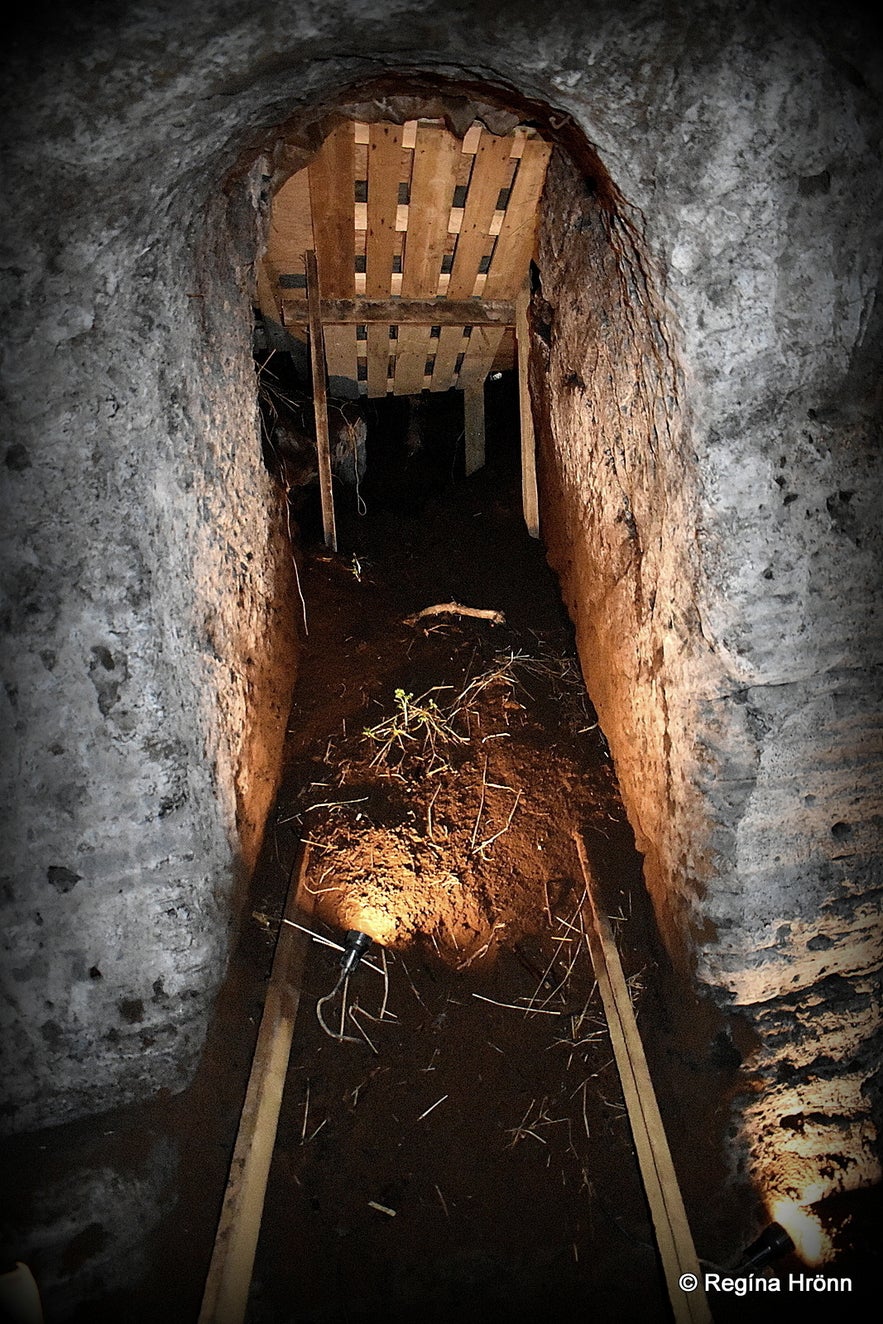
Tracks in Fjóshellir cave
To me, the most interesting part inside Fjóshellir cave is Kapellan - the Chapel. It for sure looks like a place of worship, with two sets of steps leading up to it.
It is mysterious visiting the caves, and it is cold inside so a blue mist can be seen in some of my photos. Dress accordingly when visiting the caves.
In one place there is a beautiful embossed cross in the Chapel. This might have been the location of the altar.
We are just speculating, but when you visit the Caves of Hella you will see why.
It is one of only a few embossed crosses, that we have so far found in Icelandic caves and it might have been a Corpus Christi.
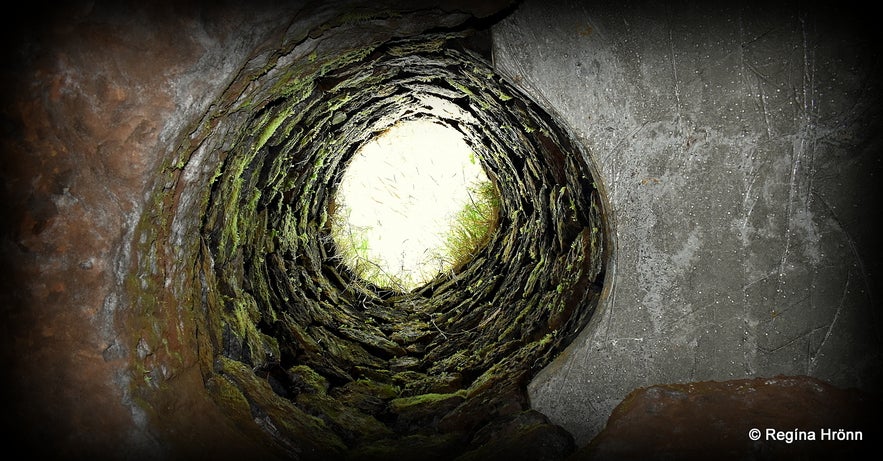
There are openings in the ceiling of the cave
No Celtic crosses have been found in the man-made caves in Iceland though.
Crosses have been carved into the walls of many other caves in South Iceland, and to me, they speak volumes.
In Fjóshellir cave you will also see engravings, which our beloved poet and sheriff in Rangárvallasýsla county, Einar Benediktsson (1864-1940), thought look like Ogham engravings.
He was an enthusiast of the Irish settlement before the settlement of Iceland and examined many of the man-made caves.
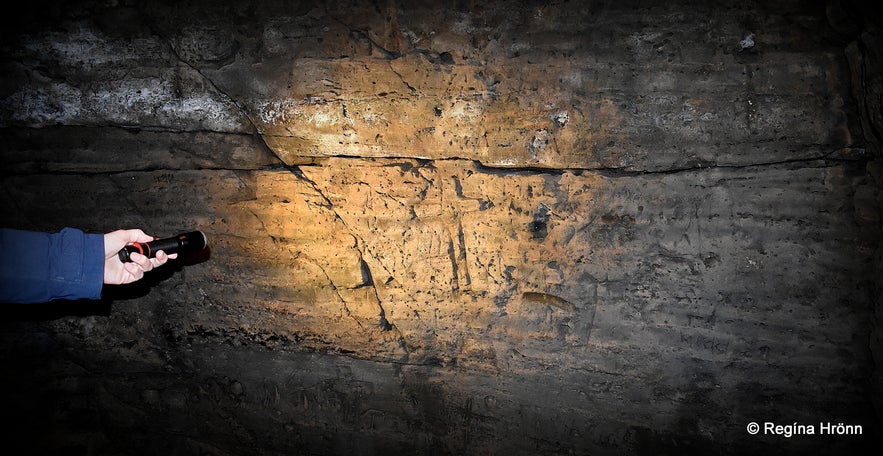
An embossed cross in the Fjóshellir cave
Ogham are ancient Irish letters and could only have been made by the Irish (Celtic people).
These engravings are very faded though from when hay was kept in the caves, and I could not photograph the engravings with any of my cameras.
But I add them anyway so that you can judge for yourself.
In 1920 Jóhannes Kjarval, who was one of Iceland's best-known painters, accompanied Einar Benediktsson into the caves and made drawings of the engravings in some of the man-made caves in South Iceland.
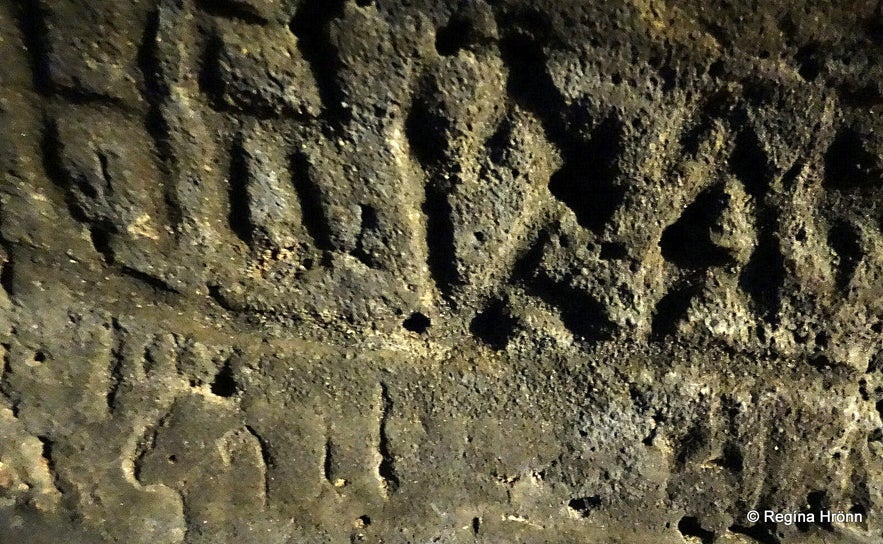 Out of focus, but are these Ogham engravings?
Out of focus, but are these Ogham engravings?
Kjarval made 11 photographic plates of Ægissíðuhellar caves, and in one of the caves, you will find information signs with one of his drawings.
The caves have eroded to some extent through the centuries, as the livestock have a habit of rubbing themselves against the cave walls.
And, the heat from the hey can erode the sandstone over time, so the caves have changed from what they originally looked like. But all the same, they are in remarkably good condition and it is amazing visiting them.
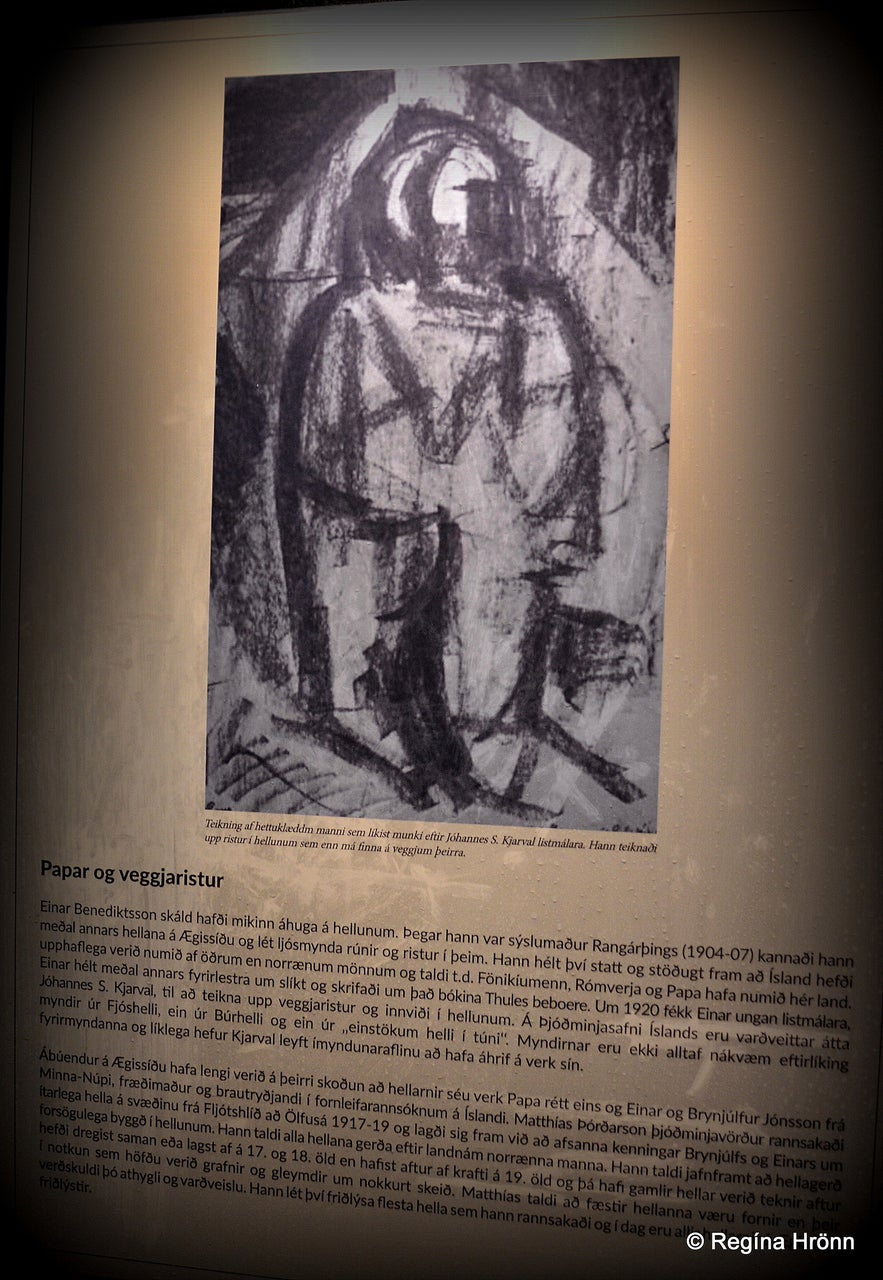 An information sign in the caves depicting one of the drawings of Jóhannes S. Kjarval
An information sign in the caves depicting one of the drawings of Jóhannes S. Kjarval
The caves are both haunting and mysterious, and candles in the caves add to the mysterious atmosphere in the caves. And in some places, you will find carved seats.
The candles are put on carved torch sconces in the walls, which might have been used to light up the cave in these old forgotten (or kept from us) times.
Were they the place of worship before the Norse settlers arrived? Will we ever find out?
People in the olden days seem to have shunned the caves and children were told to keep quiet by the caves and show respect. Why were they afraid of these caves, what happened in the man-made caves?
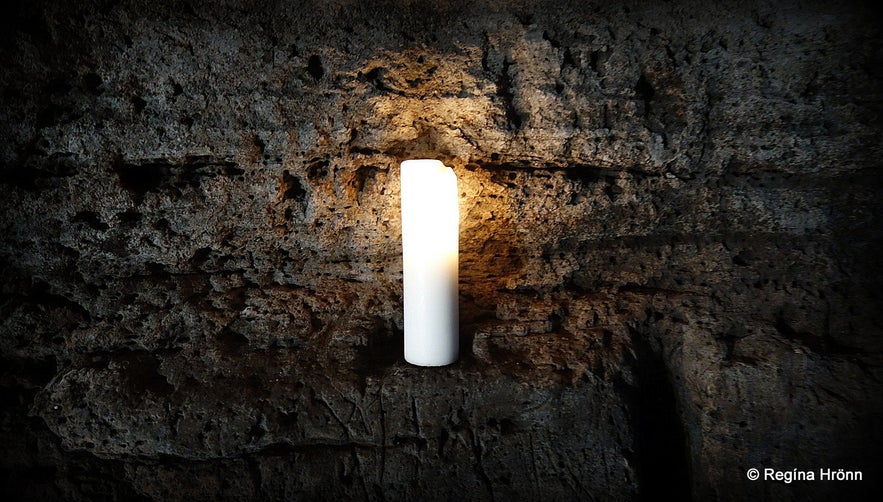 Engravings on the walls lit up by candles
Engravings on the walls lit up by candles
Did the caves keep some mysteries or secrets? Were they cursed or enchanted? It is a lost history of Iceland, which I would love to know more about.
We have the Sagas that tell us about the settlers of Iceland and the second and third generations of the settlers, but what about these people, did they really live here before the Vikings arrived?
The Vikings did not live in caves, but there are stories about the Irish monks living in sandstone caves in Ireland where there are many man-made caves.
So they most likely made these caves before the arrival of the Vikings. Again, I must reiterate, that we are just speculating here.
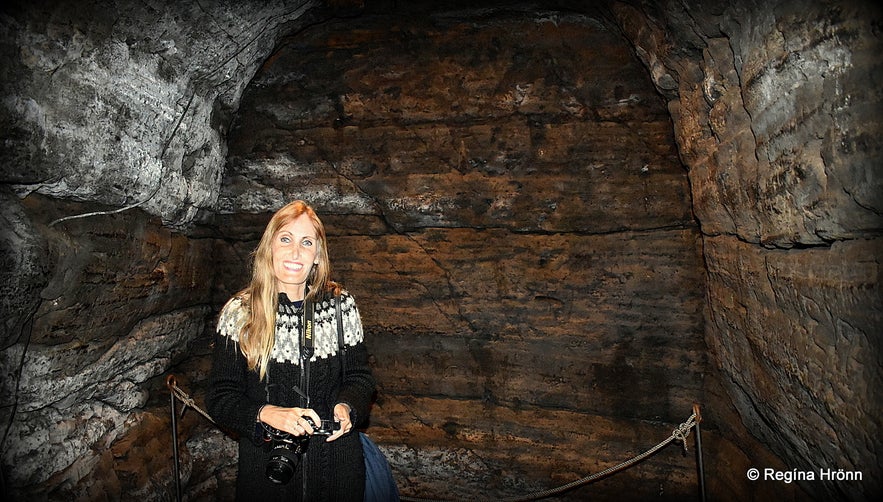 There is a cross behind me on the cave wall, but it cannot be seen clearly in this photo
There is a cross behind me on the cave wall, but it cannot be seen clearly in this photo
In one of the Icelandic Sagas, Gunnars saga Keldunúpsfífls, it is mentioned that Geir at Geirland at Síða had 10 Irish slaves.
This Saga is believed to have been written in the 14th century about events that are supposed to have happened in the 10th century.
The slave in charge was Kolur and it was his task to guard the sheep in the winter- and summertime. But he gave the other slaves the task to construct large caves on the farm of Geir for the livestock, and hey.
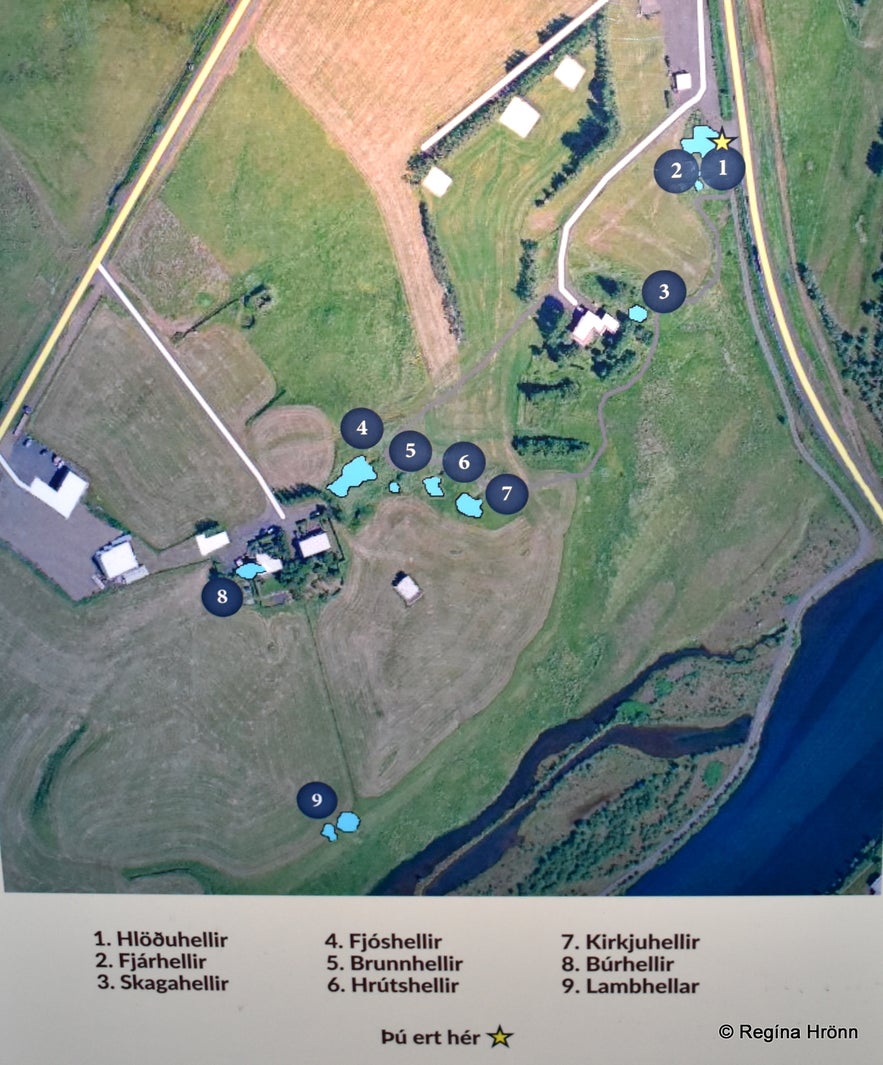 A map with the names and the location of 9 of the Caves at Hella
A map with the names and the location of 9 of the Caves at Hella
I have stayed at Geirland a couple of times, but it is now unknown where these old caves might have been.
This goes to prove that the Irish possessed the know-how of cave building from their country, which the Norwegian settlers might not have had.
And that they might have been ordered to dig these caves for the Vikings. Which makes it difficult to determine the age of the caves.
The first written source of man-made caves in Iceland is from Jarteinabók Þorláks helga - the Miracle book of St. Thorlak, who was the Bishop of Skálholt from 1178-1193, which his nephew Bishop Páll Jónsson at Skálholt (1195-1211) brought in 1199 to the parliament at Þingvellir.
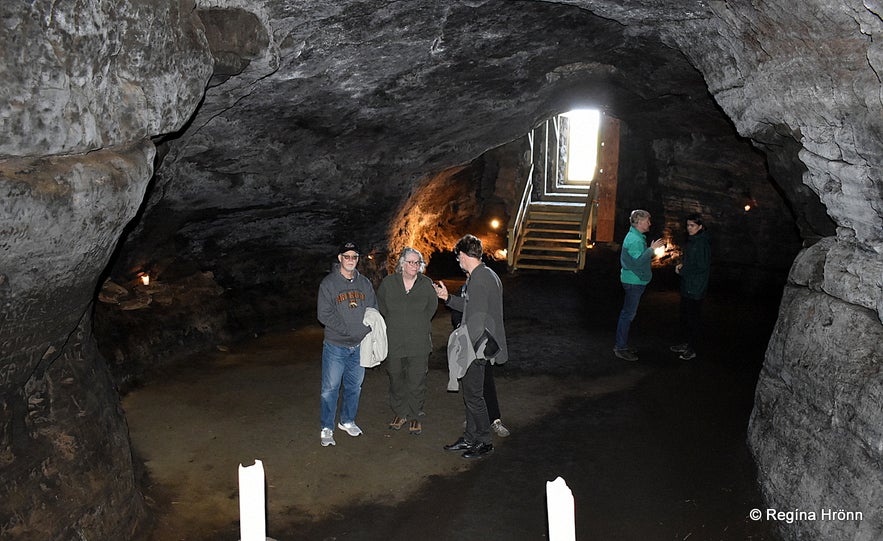
Fjóshellir cave as seen from the Chapel
We are taught at school from an early age that there were Irish monks here when the Vikings arrived, as this is the only local knowledge we have of other people living in Iceland before the Norse settlement, this foreword in Landnámabók - the Book of Settlements.
The foreword in Landnámabók also states that the holy priest Beda (Saint Bede) mentioned in his chronicle an island called Thile (Thule).
"It is written in books that it takes 6 days to sail to that island north of Britain; and he said that there is no day in the wintertime and no night in the summertime when the day is the longest. Wise men gather that Iceland was called Thile."
The English monk Beda died in the year 735 AD more than a hundred years before the Norwegians settled Iceland, the foreword in Landnámabók states.

Crosses and signs on the walls of the caves in Fjóshellir cave
The next paragraph in Landnáma tells us about the Irish monks, Papar.
In the foreword of Landnámabók it is written: "But before the Norwegians settled Iceland, here were men, whom the Norwegians call Papar; they were Christian men, and it was thought that they came from the west, as they left Irish books, bells and crosiers and more items, so it is believed that they were Vestmenn - Westmen.
It is also mentioned in English books, that back then people were sailing between these 2 countries."
In the olden times, the Norse Vikings called the Gaelic people Vestmenn (Westmen).
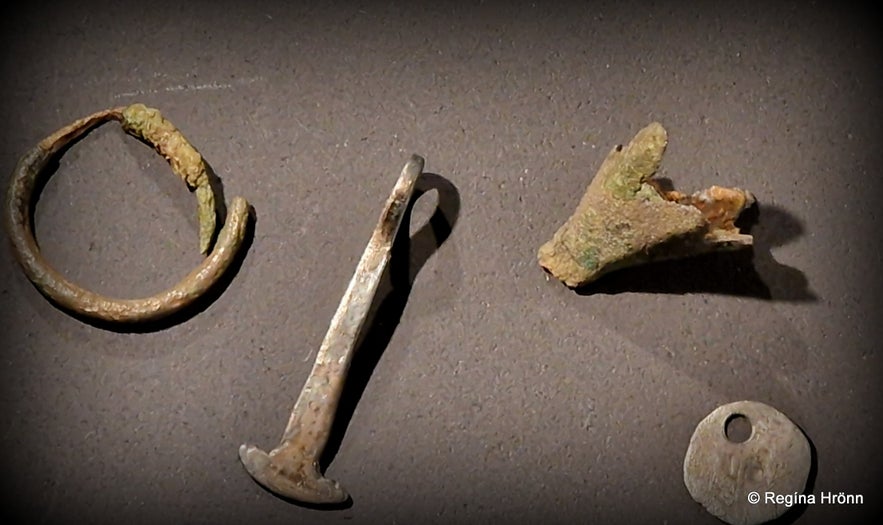 One of the old bells at Þjóðminjasafnið - the National Museum of Iceland
One of the old bells at Þjóðminjasafnið - the National Museum of Iceland
Small bells of all kinds were characteristic of the rituals of the Irish church.
And, in at least 3 pagan graves in Iceland (at Kornsá in Vatnsdalur valley, in Vatnsdalur in Patreksfjörður, and Brú in Biskupstungur) small bronze bells have been found, that might have been Irish bells, might not, but they were used as decoration on necklaces.
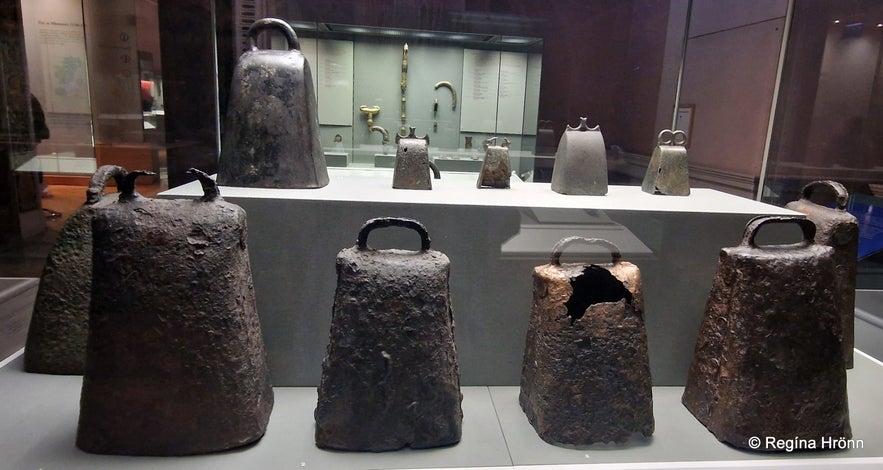 Old Irish bells in the National Museum of Ireland
Old Irish bells in the National Museum of Ireland
The bell in Vatnsdalur is most likely from the British Isles, where Nordic people lived.
These bells are an interesting find, whatever their origin might be.
Why the Papar left their valuable Christian belongings behind we don't understand, unless they were driven away or even killed? We are trying to read between the lines here...
The story is written down by the descendants of the Norwegian settlers, so they "might be" partial in their account and maybe they did not tell us the whole story.

Ari fróði - the Wise, the father of Icelandic historiography, wrote Íslendingabók or the Book of Icelanders, which is the early history of Icelanders.
Ari wrote Íslendingabók in 1122-1132 - the first written work of history in Iceland from the settlement until 1118.
His last sentence in Íslendingabók is: "En hvatki er missagt er í fræðum þessum þá er skylt að hafa það heldur sem sannara reynist" and I have always wondered why he added this sentence at the end.
This sentence translated into English means: "If anything proves to be wrong in these writings then it must be corrected and the truth be told".
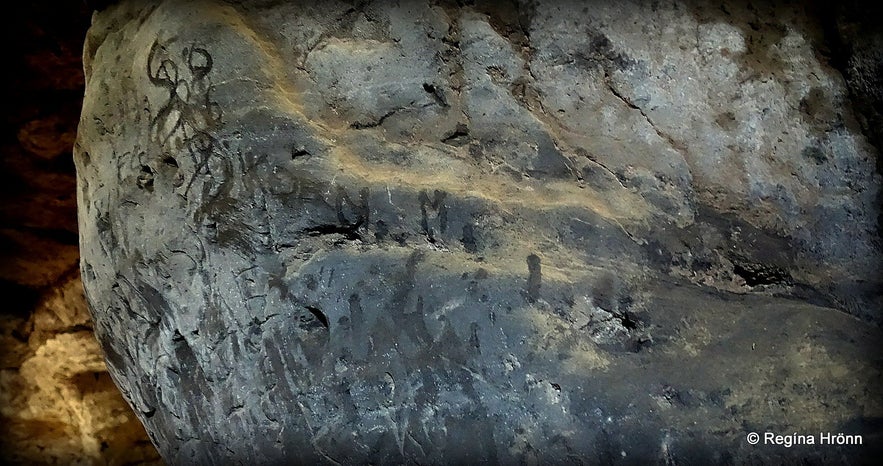
Engravings on the cave walls in Fjóshellir cave
The noted Árni Óla states in his book Grúsk - pages 36-37, that the Irish might have arrived at least some 150 years earlier than the settlers did.
And, in the Mensura orbis terrae, written in 825 by the Irish monk Dicuilius, he mentions Irish hermits who were in Thule some 30 years earlier (795), and that they had marveled at the midnight sun.
He did not mention though when the Irish first arrived in Iceland, which might have been earlier than in the 8th century.
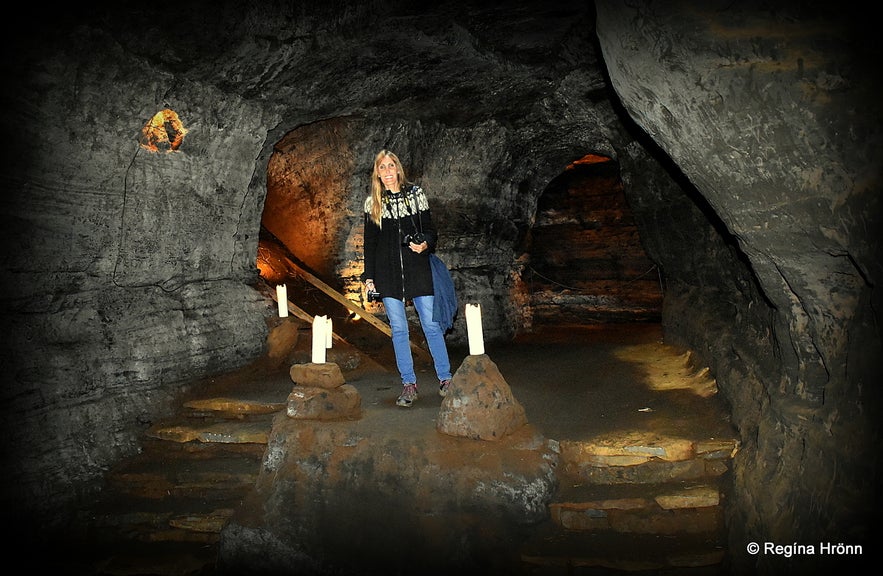
I stayed behind for a couple of minutes in Fjóshellir to try to sense the spiritual energy of the cave
The Vikings were heathen, believers in the old Norse faith, Óðinn and Þór, and it wasn't until the year 1000 that the Vikings adopted Christianity.
There had been some Christian settlers though, like the noted Auður djúpúðga and her siblings Þórunn hyrna and Helgi bjóla, who settled Eyjafjörður in North Iceland and Kjalarnes in South Iceland.
The Vikings brought with them Irish slaves, who were Christian. Was there a larger Irish population here when the Vikings arrived? This theory is controversial, but not unlikely.
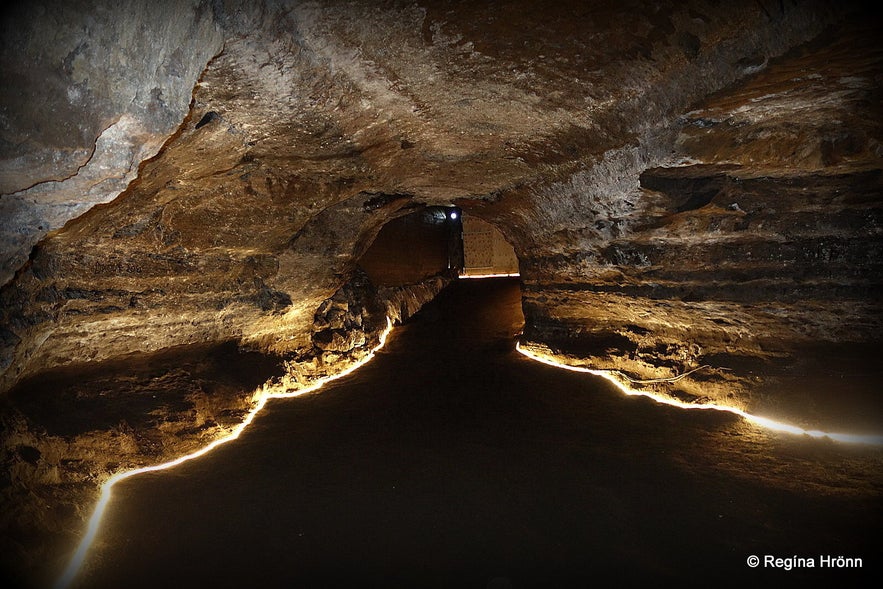 In Hlöðuhellir cave
In Hlöðuhellir cave
There are old stories in Ireland about there being an Irish population here in Iceland long before it was settled by the Norwegian Vikings (they were not all Vikings, but I refer to them in that way).
Did the Vikings kill them, drive them away, or incorporate them into their settlement?
And how did the Vikings treat their Irish slaves in the Sagas?
In the old Icelandic Sagas, all of which I have read with great enthusiasm, there are many mentions of the Irish slaves.
It always bothers me when I read the Sagas how badly they were treated and how stupid and clumsy they are depicted in many of the Sagas. And, they are very often referred to as having possessed the powers of sorcery.
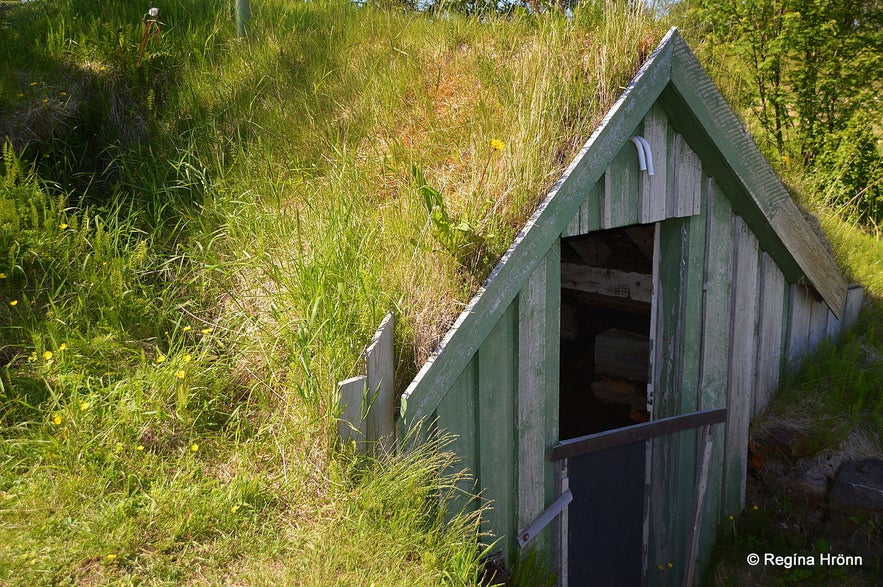 The entrance to one of the caves
The entrance to one of the caves
We, Icelanders, have no ancient habitations of our forefathers, as Icelanders lived in turf houses that had to be constantly maintained and collapsed if they were left on their own.
So these caves with all the engravings; the underground habitations (if they were habitations), are of special interest to us.
We have many archaeological sites though where the ruins of the old Viking houses have been dug out. Some of the archaeological ruins predate the settlement of Iceland, and some of them might have been fishing stations.
I have written another travel blog: Ancient Archaeological Viking Ruins and Burial Mounds I have visited on my Travels in Iceland, if you want to see where to find ancient ruins in Iceland.
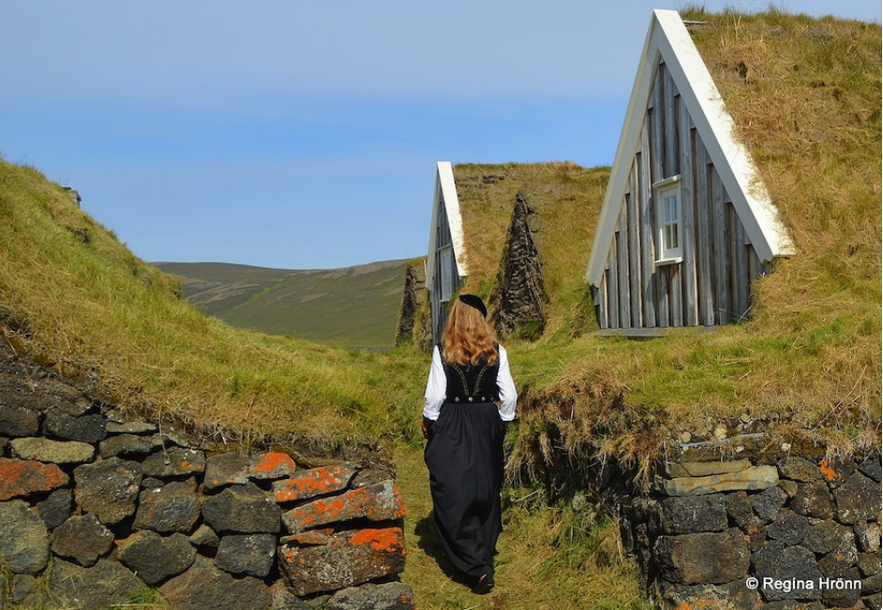
If you want to visit the Caves of Hella, this is the standard tour that I joined on two occasions: Caves of Hella Guided Tour | Archaeological Exploration of Iceland's Oldest Man-Made Site.
There are also concerts and happenings in the caves as there are great acoustics, especially in Hlöðuhellir cave according to Baldur (Bændablaðið). There have even been wedding ceremonies in the caves.
American experts in medieval art history and geology have been examining the caves with advanced technology and we are eagerly waiting for their results.
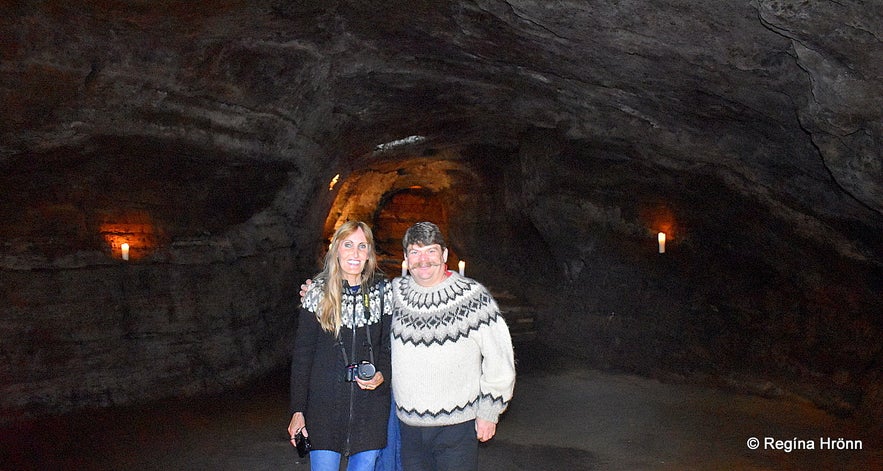
In Fjóshellir cave
The Caves of Hella are very accessible as they are right by the ring road right before you reach the river Ytri-Rangá and the village Hella in Rangárþing ytra (given that you are driving in the east direction from Reykjavík).
A big thank you to the owners of the caves, for making them so accessible! Have a lovely time in the Caves of Hella, and enjoy your Iceland visit :)
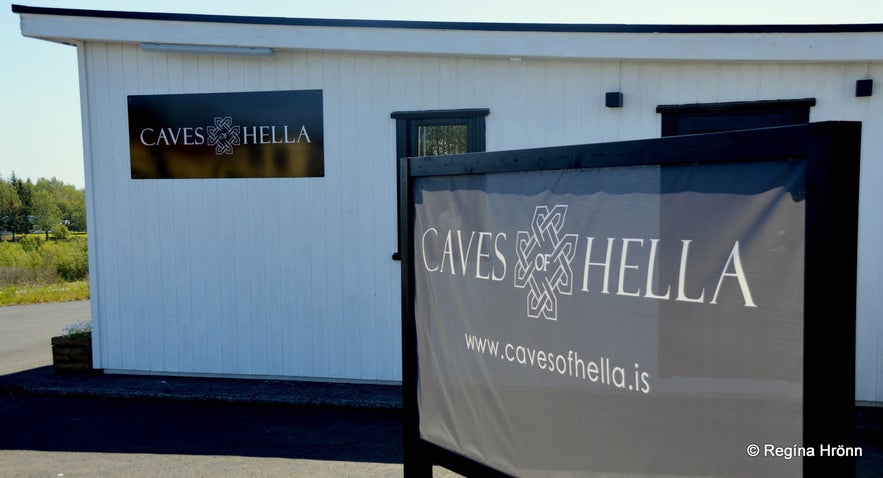
Ref:
Hellarnir á Hellu - the Caves of Hella
Landnámabók - the foreword
Bændablaðið - Hellarnir við Ægissíðu á Hellu
Grúsk - Árni Óla - pages 31-37
Landnámið fyrir landnám - Árni Óla
Manngerðir hellar á Íslandi pages 144-163
Kuml og haugfé by Kristján Eldjárn - pages 23-25 and 387-389
Gunnars saga Keldunúpsfífls chapter 1
Will American scientists discover the origins of the Caves of Hella?


